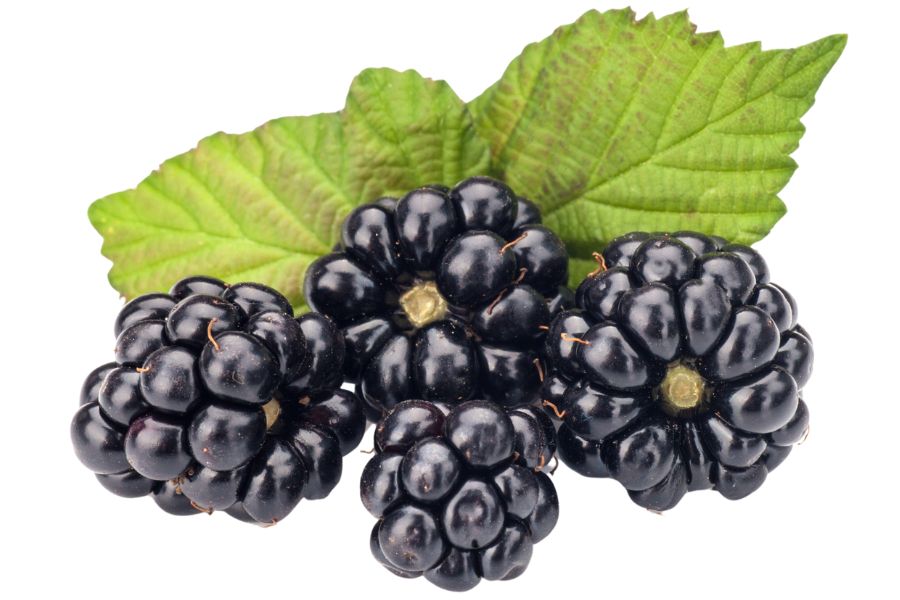Missouri has a surprising number of wild edible plants that most people walk past without a second thought. Wild grape vines hang heavy in some areas, and curly dock can be sautéed or dried depending on the season. Then there are plants like mayapple, which are only edible in very specific ways.
Many of these plants have long histories of use and were foraged regularly generations ago. Dandelion leaves and roots, for example, have both culinary and medicinal applications. But not all of them are easy to recognize unless you already know the details.
There are bitter greens, fruity snacks, and even roots that can be dug and cooked. Some edible plants here only show themselves briefly before disappearing for the year. The more you learn, the more likely you are to come home with a basket full of variety.
What We Cover In This Article:
- The Edible Plants Found in the State
- Toxic Plants That Look Like Edible Plants
- How to Get the Best Results Foraging
- Where to Find Forageables in the State
- Peak Foraging Seasons
- The extensive local experience and understanding of our team
- Input from multiple local foragers and foraging groups
- The accessibility of the various locations
- Safety and potential hazards when collecting
- Private and public locations
- A desire to include locations for both experienced foragers and those who are just starting out
Using these weights we think we’ve put together the best list out there for just about any forager to be successful!
A Quick Reminder
Before we get into the specifics about where and how to find these plants and mushrooms, we want to be clear that before ingesting any wild plant or mushroom, it should be identified with 100% certainty as edible by someone qualified and experienced in mushroom and plant identification, such as a professional mycologist or an expert forager. Misidentification can lead to serious illness or death.
All plants and mushrooms have the potential to cause severe adverse reactions in certain individuals, even death. If you are consuming wild foragables, it is crucial to cook them thoroughly and properly and only eat a small portion to test for personal tolerance. Some people may have allergies or sensitivities to specific mushrooms and plants, even if they are considered safe for others.
The information provided in this article is for general informational and educational purposes only. Foraging involves inherent risks.
The Edible Plants Found in the State
Wild plants found across the state can add fresh, seasonal ingredients to your meals:
American Persimmon (Diospyros virginiana)
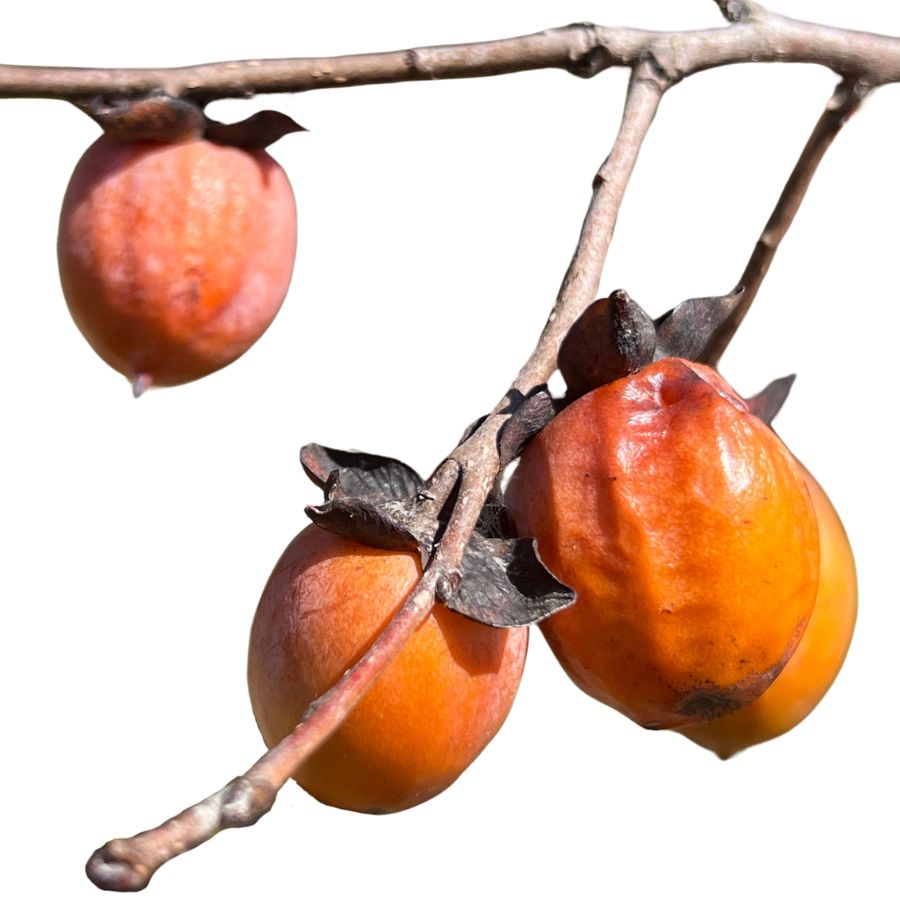
Persimmon, sometimes called American persimmon or common persimmon, grows as a small tree with rough, blocky bark and oval-shaped leaves. The fruit looks like a small, flattened tomato and turns a deep orange or reddish color when ripe.
If you bite into an unripe persimmon, you will quickly notice an extremely astringent, mouth-drying effect. A ripe persimmon, on the other hand, tastes sweet, rich, and custard-like, with a soft and jelly-like texture inside.
You can eat persimmons fresh once they are fully ripe, or you can cook them down into puddings, jams, and baked goods. Some people also mash and freeze the pulp to use later for pies, breads, and sauces.
Wild persimmons can sometimes be confused with black nightshade berries, but nightshade fruits are much smaller, grow in clusters, and stay dark purple or black. Only the ripe fruit of the persimmon tree should be eaten; the seeds and the unripe fruit are not edible.
Meadow Garlic (Allium canadense)
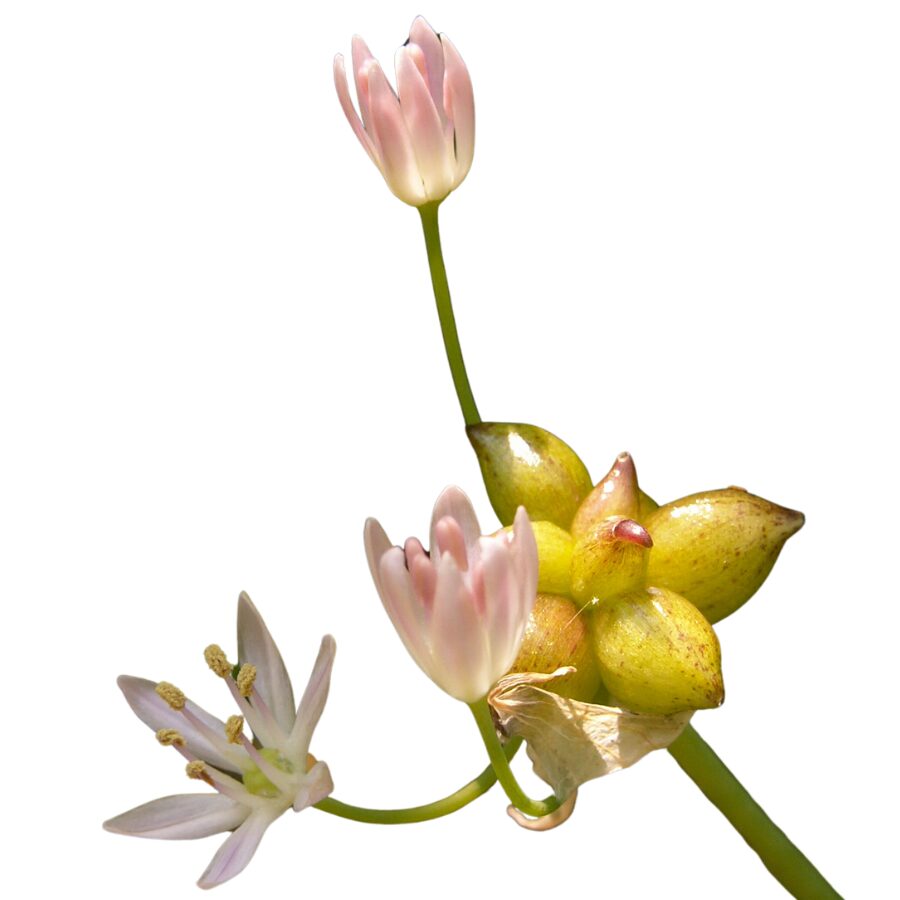
Meadow garlic, also called wild onion or wild garlic, grows in clumps with slender hollow leaves and small pink or white flowers. You’ll recognize it by the onion scent released when you bruise the stems or dig into the bulb.
The edible parts include the bulbs, stems, leaves, and flowers, all of which have a mild onion flavor and crisp texture. Cook them as you would scallions—sautéed, grilled, or tossed raw into salads.
False garlic, or crow poison, looks similar but lacks the onion smell and can be toxic if eaten. Always crush the plant before harvesting—no onion scent means don’t eat it.
Many people pickle the bulbs or chop the greens for compound butters and dips. Be cautious where you forage it though, as plants growing near roadsides or sprayed areas can absorb contaminants.
American Plum (Prunus americana)
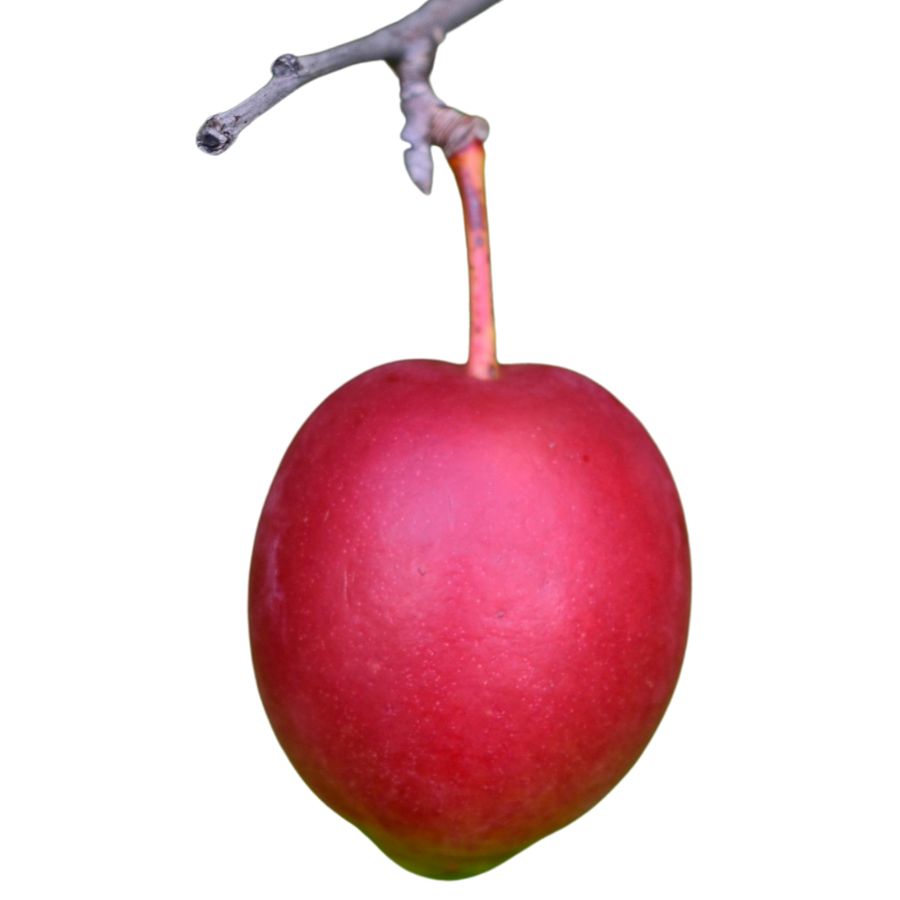
American plum, also called wild plum or river plum, produces small round fruits that range in color from yellow to deep red when ripe. The skin is slightly tart, but the flesh is soft, juicy, and sweet with a hint of spice.
You can eat the fruit raw or turn it into jellies, sauces, or wines—its natural pectin makes it ideal for preserves. Just avoid the seeds and leaves, which contain compounds that can release cyanide when crushed or chewed.
Its bark is rough and dark, and the branches often have short, sharp spines. The plant’s simple oval leaves and white spring flowers help distinguish it from less edible lookalikes like black cherry, which has longer, narrower leaves with a more bitter fruit.
If the fruit has a strong bitter almond smell when crushed, steer clear—it might be a different species altogether. American plum fruit clusters tend to be smaller and more tightly packed than those of cultivated varieties.
Lamb’s Quarters (Chenopodium album)
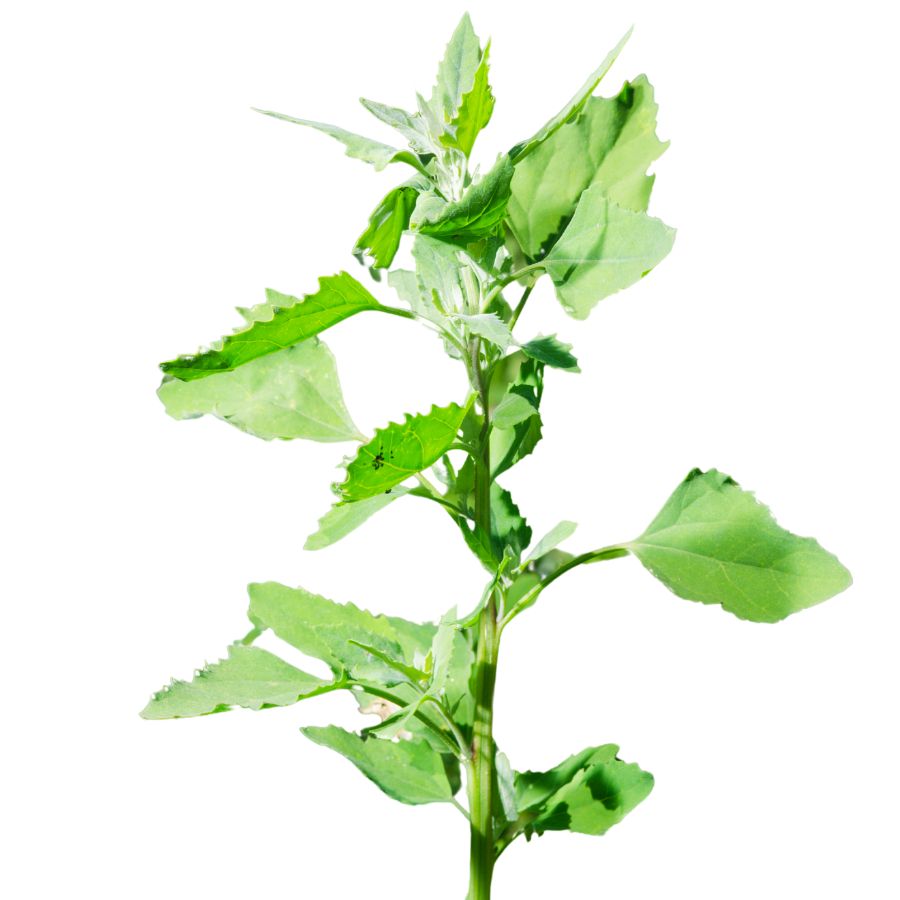
Lamb’s quarters, also called wild spinach and pigweed, has soft green leaves that often look dusted with a white, powdery coating. The leaves are shaped a little like goose feet, with slightly jagged edges and a smooth underside that feels almost velvety when you touch it.
A few plants can be confused with lamb’s quarters, like some types of nightshade, but true lamb’s quarters never have berries and its leaves are usually coated in that distinctive white bloom. Always check that the stems are grooved and not round and smooth like the poisonous lookalikes.
When you taste lamb’s quarters, you will notice it has a mild, slightly nutty flavor that gets richer when cooked. The young leaves, tender stems, and even the seeds are all edible, but you should avoid eating the older stems because they become tough and stringy.
People often sauté lamb’s quarters like spinach, blend it into smoothies, or dry the leaves for later use in soups and stews. It is also rich in oxalates, so you will want to cook it before eating large amounts to avoid any problems.
Pawpaw (Asimina triloba)
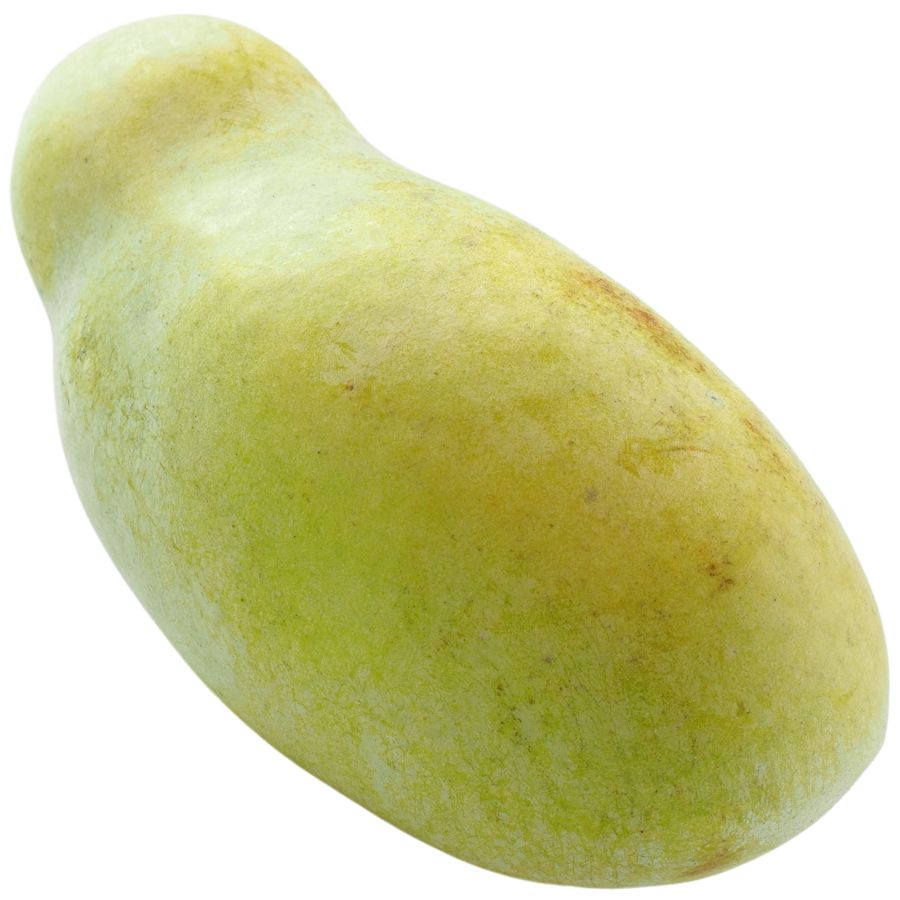
The pawpaw grows fruits that are green and shaped a little like small mangoes. Inside, the soft yellow flesh tastes like a blend of banana, mango, and melon, with a custard-like texture that melts in your mouth.
If you are comparing it to similar plants, keep in mind that young pawpaw trees can look a little like young magnolias because of their large leaves. True pawpaws grow fruits with large brown seeds tucked inside, while magnolias do not produce anything that looks or tastes similar.
You can eat the flesh straight out of the skin with a spoon, or mash it into puddings, smoothies, and even homemade ice cream. Some people also like to freeze it into cubes for later, although it does tend to brown quickly once exposed to air.
Stick to eating the soft inner flesh. Make sure not to ingest the skin and seeds of the fruit because they contain compounds that can upset your stomach.
This fruit is that it was a favorite snack of Native Americans and early explorers long before it started showing up in backyard gardens.
Wild Garlic (Allium vineale)
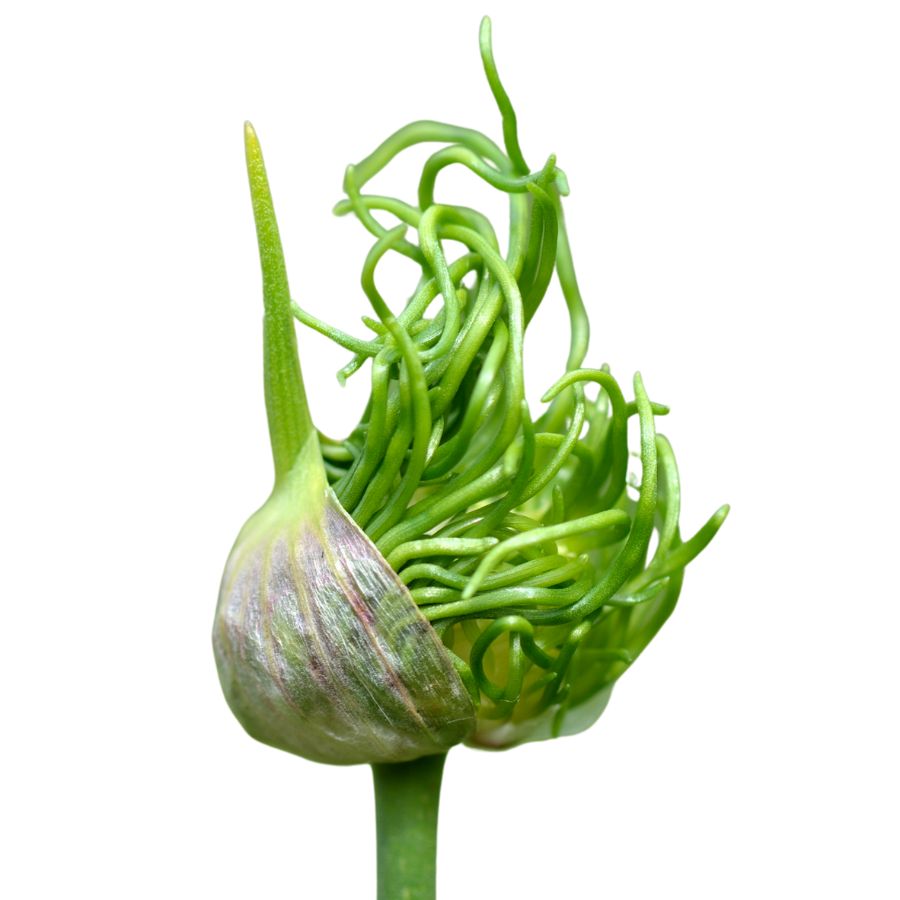
Wild garlic has slender, hollow leaves that look a lot like chives. When you crush the leaves or bulbs between your fingers, they release a strong garlicky smell that makes identification easier.
The are both edible, and You can use the bulbs and leaves raw or cooked in different dishes. Just make sure you are not mistaking it for toxic lookalikes like death camas, which does not smell like garlic at all.
Wild garlic has a sharp, onion-garlic flavor that becomes milder when cooked. You can chop the leaves into salads, stir them into soups, or blend them into sauces like pesto.
One thing to watch for is that the bulbs can sometimes have a tough, fibrous outer layer you will want to peel away before eating. If you want the best flavor, focus on younger, tender leaves rather than older, stringy ones.
Jerusalem Artichoke (Helianthus tuberosus)
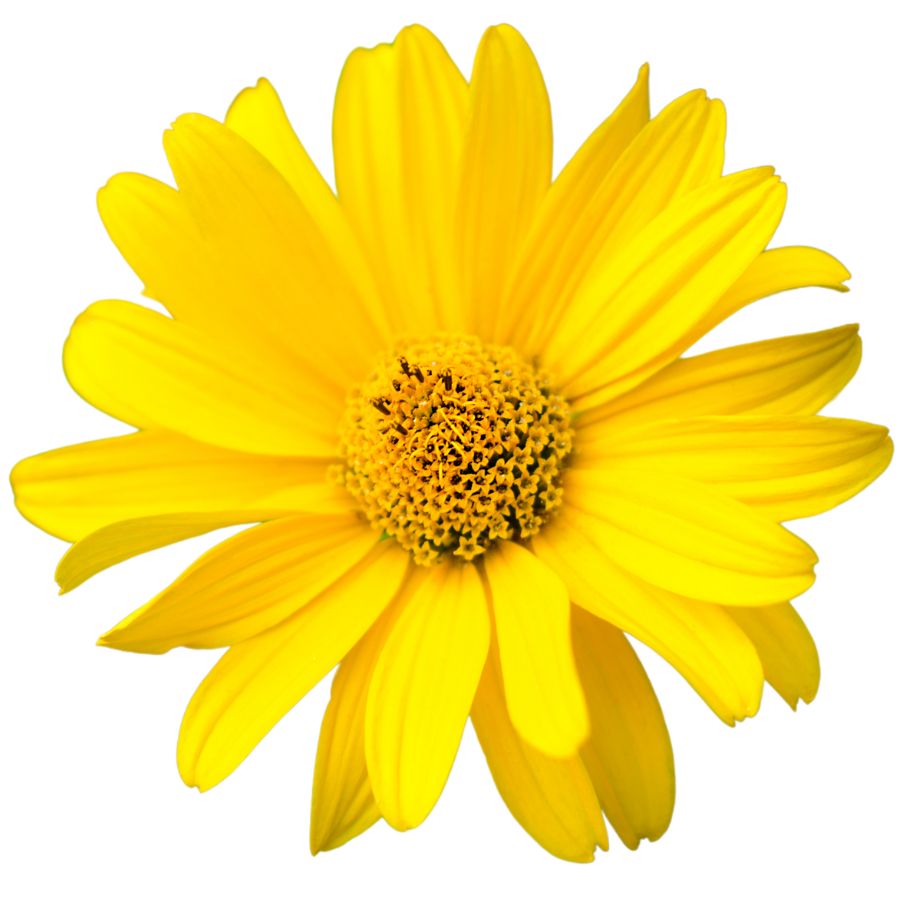
Jerusalem artichoke grows tall with sunflower-like blooms and has knobby underground tubers. The tubers are tan or reddish and look a bit like ginger root, though they belong to the sunflower family.
The part you’re after is the tuber, which has a nutty, slightly sweet flavor and a crisp texture when raw. You can roast, sauté, boil, or mash them like potatoes, and they hold their shape well in soups and stir-fries.
Some people experience gas or bloating after eating sunchokes due to the inulin they contain, so it’s a good idea to try a small amount first. Cooking them thoroughly can help reduce the chances of digestive discomfort.
Sunchokes don’t have many dangerous lookalikes, but it’s important not to confuse the plant with other sunflower relatives that don’t produce tubers. The above-ground part resembles a small sunflower, but it’s the knotted, underground tubers that are worth digging up.
Blackberry (Rubus allegheniensis)
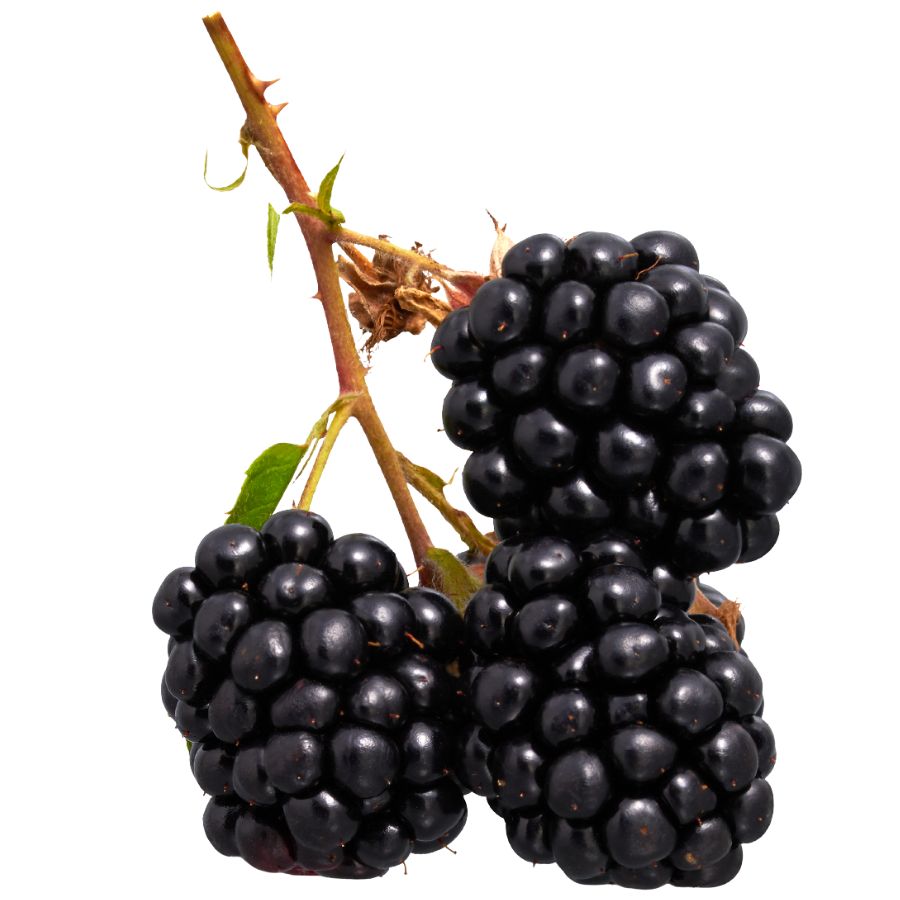
Blackberry, also known as brambleberry or dewberry, grows on thick, thorny canes that can arch and spread across the ground. The leaves are usually serrated, and the fruit ripens from green to red before turning deep purple or black when fully ready to pick.
The berries have a sweet, tangy flavor with a soft, juicy texture that easily bursts in your mouth. You can eat them raw, bake them into pies and cobblers, or preserve them by making jams and jellies.
Only the ripe fruit of the blackberry plant is edible, while the stems and leaves are not usually eaten.
Some plants like black raspberry can look similar, but black raspberries are hollow in the center when picked while blackberries have a solid core. It’s important to avoid confusing blackberries with nightshade berries, which grow on upright plants without thorny vines and can be toxic.
An interesting thing about blackberries is that they are technically not a single berry but a cluster of small drupelets packed together.
Smartweed (Persicaria hydropiper)
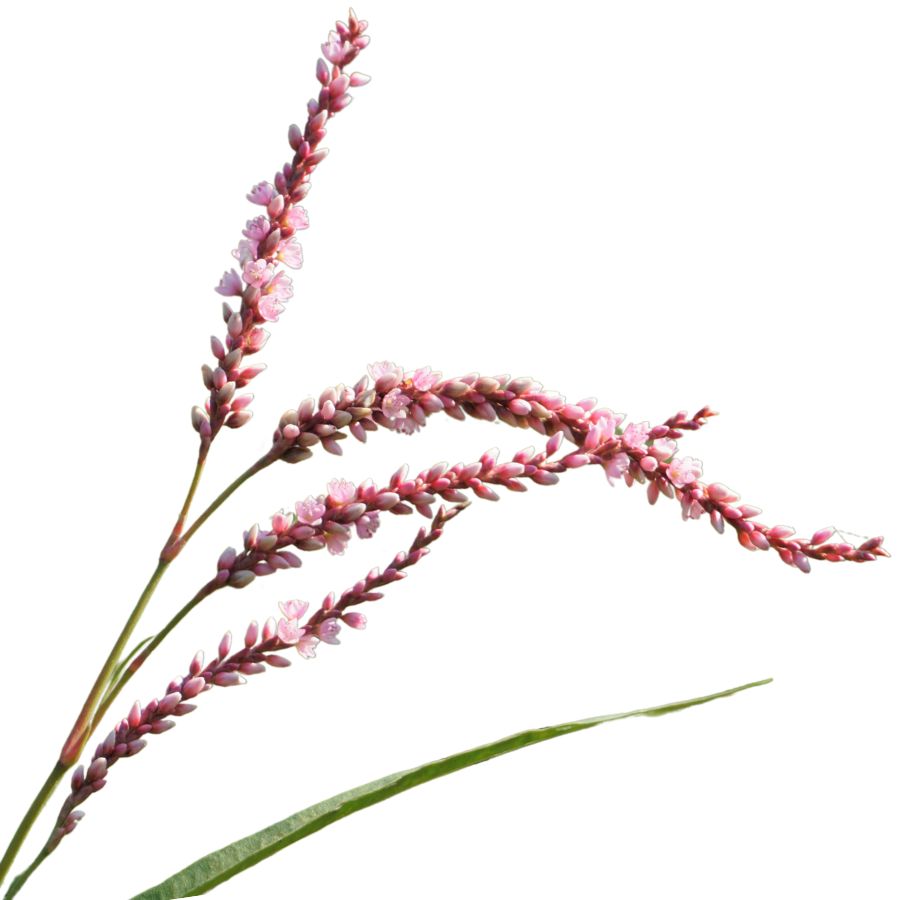
Smartweed, also called water pepper or knotweed, grows with lance-shaped leaves and reddish joints where the leaves meet the stem. The flowers form dense, drooping clusters that range from pale pink to white.
What sets this plant apart is the fiery kick packed in the leaves—it’s strong enough to numb your tongue if you’re not expecting it. The fresh greens can be finely chopped into soups or paired with vinegar to mellow out the intensity.
Avoid confusing it with other Persicaria species like Pennsylvania smartweed, which is milder and has more upright flower spikes. The edible part is strictly the leaf—everything else is either too bitter or too tough to use.
If you’re into bold flavors, smartweed just might be for you. Just don’t overdo it raw unless you’re into eye-watering heat.
Spicebush (Lindera benzoin)
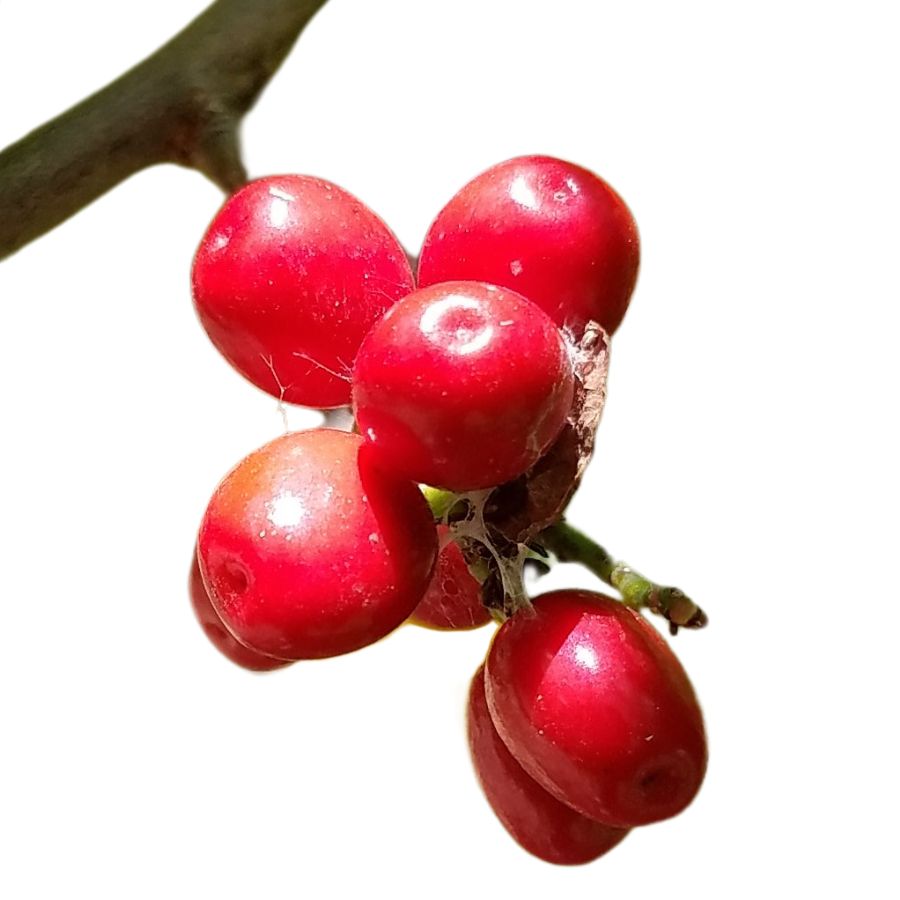
Spicebush has smooth-edged leaves that release a spicy citrus scent when crushed, and it produces clusters of red berries that grow close to the stem. Those berries, along with the young twigs and leaves, are all edible and flavorful.
The berries are especially valued for their warm, peppery kick and are often dried and ground as a seasoning. You can steep the leaves and twigs into tea or simmer them into broths.
Avoid confusing it with lookalikes like Carolina allspice, which has larger, thicker leaves and lacks the same aromatic quality. Its berries also differ in size and internal seed structure.
Spicebush has a long history of use in traditional cooking for its mild numbing effect and warming flavor. Only the berries, leaves, and tender twigs should be consumed—avoid the bark and roots.
Dandelion (Taraxacum officinale)
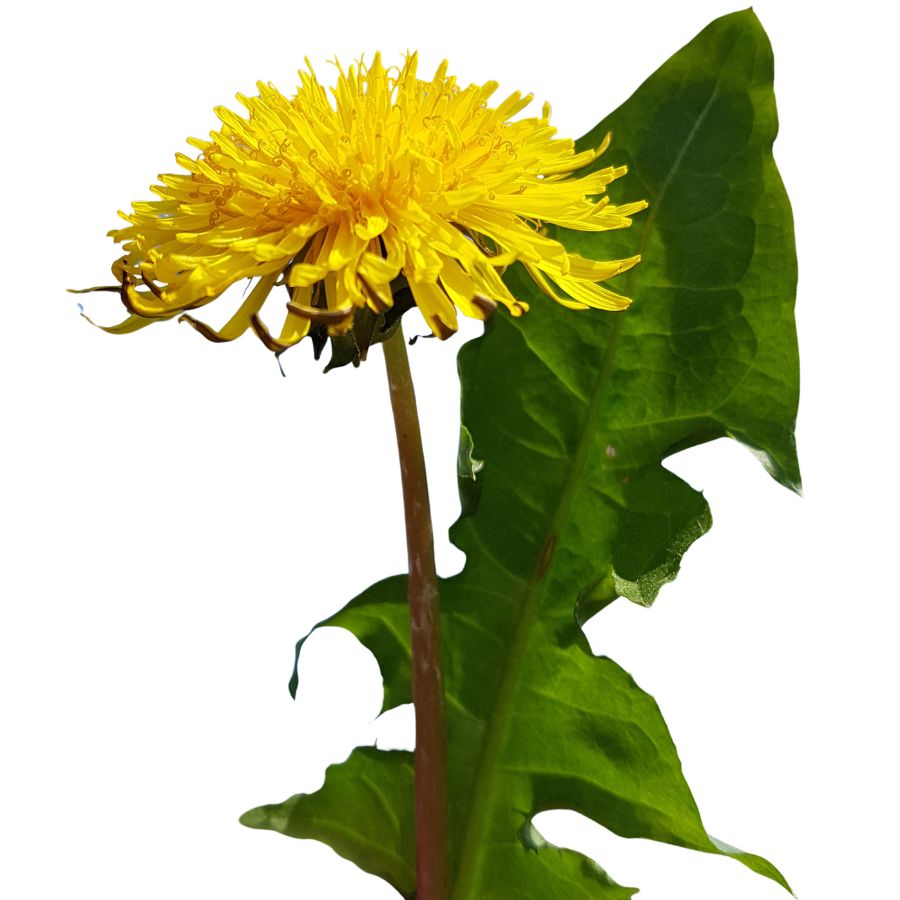
Bright yellow flowers and jagged, deeply toothed leaves make dandelions easy to spot in open fields, lawns, and roadsides. You might also hear them called lion’s tooth, blowball, or puffball once the flowers turn into round, white seed heads.
Every part of the dandelion is edible, but you will want to avoid harvesting from places treated with pesticides or roadside areas with heavy car traffic. Besides being a food source, dandelions have been used traditionally for simple herbal remedies and natural dye projects.
Young dandelion leaves have a slightly bitter, peppery flavor that works well in salads or sautés, and the flowers can be fried into fritters or brewed into tea. Some people even roast the roots to make a coffee substitute with a rich, earthy taste.
One thing to watch out for is cat’s ear, a common lookalike with hairy leaves and branching flower stems instead of a single, hollow one. To make sure you have a true dandelion, check for a smooth, hairless stem that oozes a milky sap when broken.
Cattail (Typha latifolia)
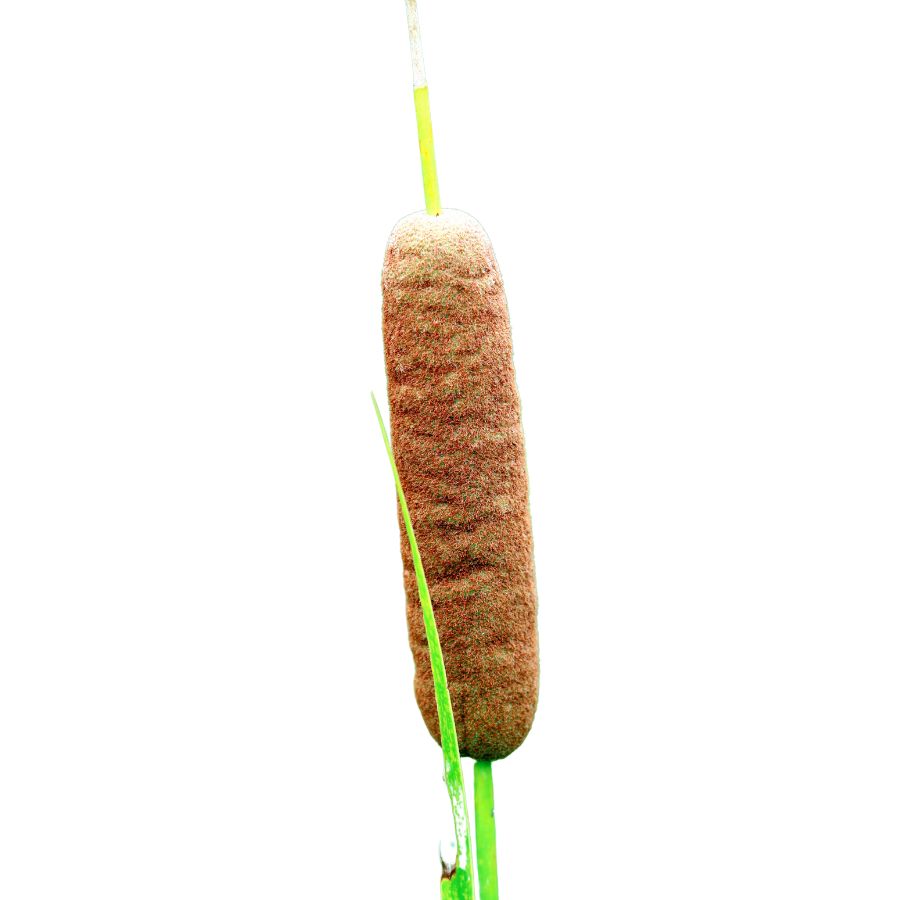
Cattails, often called bulrushes or corn dog grass, are easy to spot with their tall green stalks and brown, sausage-shaped flower heads. They grow thickly along the edges of ponds, lakes, and marshes, forming dense stands that are hard to miss.
Almost every part of the cattail is edible, including the young shoots, flower heads, and starchy rhizomes. You can eat the tender shoots raw, boil the flower heads like corn on the cob, or grind the rhizomes into flour for baking.
Besides food, cattails have long been used for making mats, baskets, and even insulation by weaving the dried leaves and using the fluffy seeds. Their combination of usefulness and abundance has made them an important survival plant for many cultures.
One thing you need to watch for is young cattail shoots being confused with similar-looking plants like iris, which are toxic. A real cattail shoot will have a mild cucumber-like smell when you snap it open, while iris plants smell bitter or unpleasant.
Hairy Bittercress (Cardamine hirsuta)
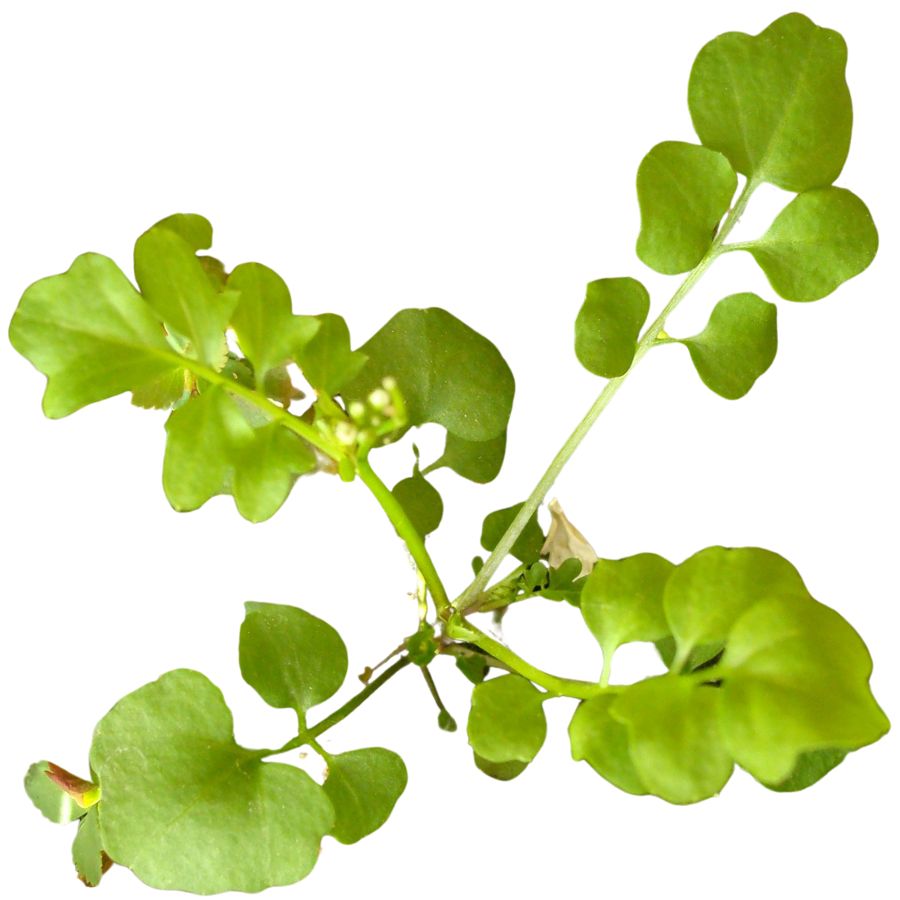
Hairy bittercress is a weedy edible with spoon-shaped leaves and four-petaled white flowers. It tends to grow low to the ground in a circular pattern, with seed pods stretching upright like antennae.
Its flavor is peppery with a crisp bite, especially when fresh, and it’s a solid option for spicing up sandwiches or grain bowls. Most people eat the entire plant except for the roots.
Cardamine flexuosa is a close visual match but has more leaflets per leaf and lacks the same intensity of flavor. You’ll also notice that hairy bittercress has straighter seed pods and slightly rougher stems.
It’s often eaten raw, though a quick sauté mellows the bite and helps blend it into cooked greens. The plant bruises and wilts quickly, so eat it shortly after picking.
Milkweed (Asclepias syriaca)
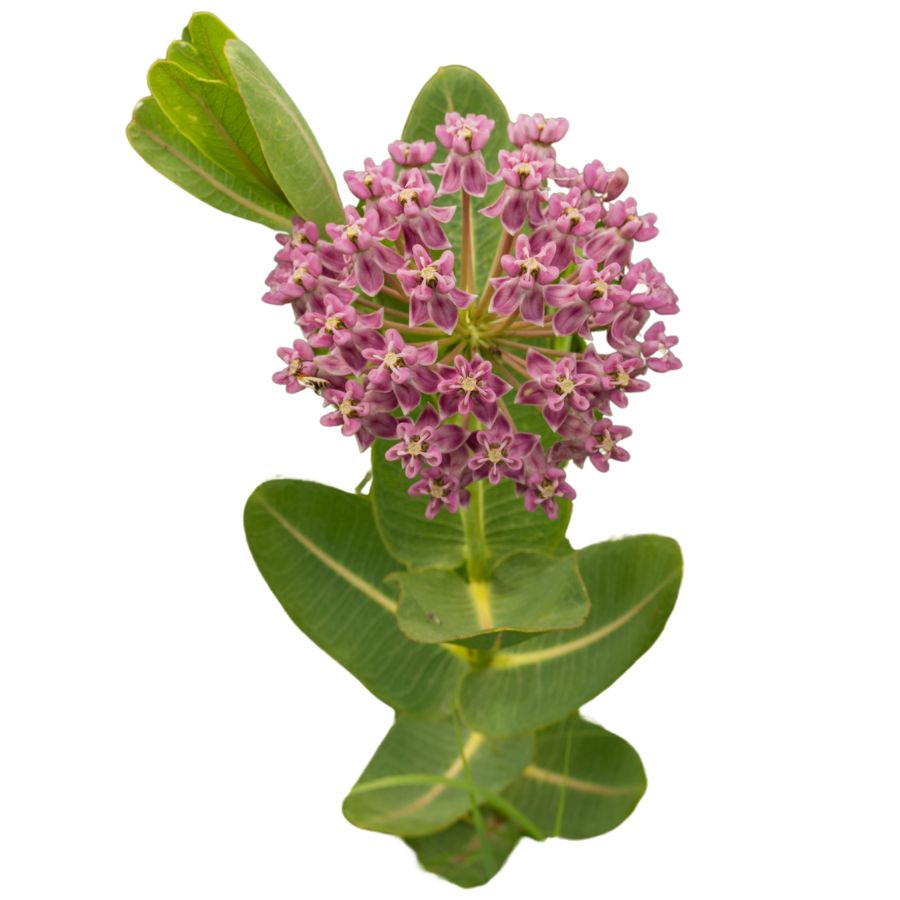
Known for its thick stems, broad leaves, and clusters of pinkish-purple flowers, common milkweed is sometimes called silkweed or butterfly flower. When you snap a stem or leaf, it releases a milky sap that helps you tell it apart from other plants that can be harmful.
If you want to try it in the kitchen, focus on gathering the young shoots, the tightly closed flower buds, and the small, immature pods. These parts have a mild, slightly sweet flavor when cooked, and their soft texture makes them a good addition to soups, sautés, and fritters.
Getting it ready to eat takes a little care, since boiling the plant parts in several changes of water helps remove bitterness and unwanted compounds. Some people also like to steam the buds or fry the pods lightly to bring out their best taste.
Although monarch caterpillars rely on this plant for survival, it has a long history of being used by people as well. Watch out for lookalikes like dogbane, though, since they share the same milky sap but are dangerously toxic if eaten.
Mulberry (Morus rubra)
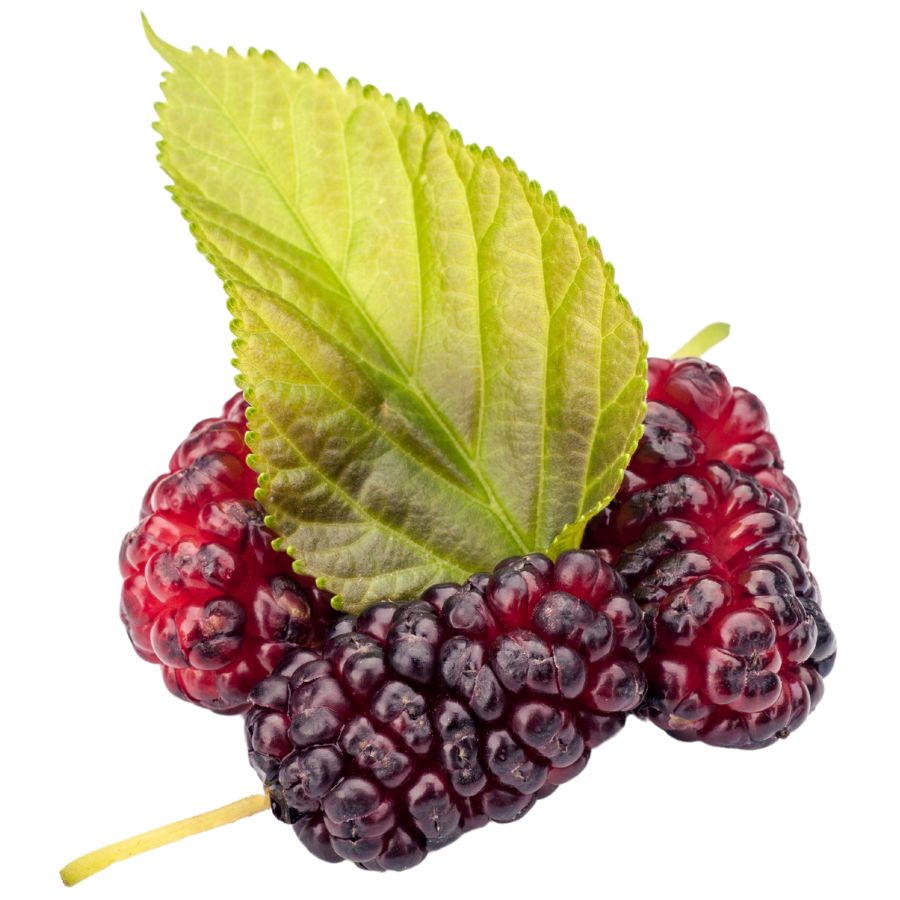
Sweet, juicy, and often overlooked, mulberries are one of the easiest wild berries to recognize. Known by names like white mulberry and red mulberry, these trees produce small, blackberry-like fruits that range from pale pink to deep purple.
The berries have a soft, almost melting texture with a mild tartness behind the sugar. You can eat them fresh by the handful, bake them into pies, or simmer them down into homemade jams and syrups.
While the fruits are safe and delicious when ripe, you should avoid eating the unripe berries or any part of the tree’s sap, which can cause stomach upset. It is also worth knowing that mulberries are delicate and bruise easily when picked, so handle them gently.
Red osier dogwood and some honeysuckles can produce berries that look similar from a distance, but true mulberries grow singly or in loose clusters along the branches and have a distinctive leaf shape that sets them apart. Always double-check the leaf texture and berry arrangement before eating any wild fruits.
Elderberry (Sambucus canadensis)
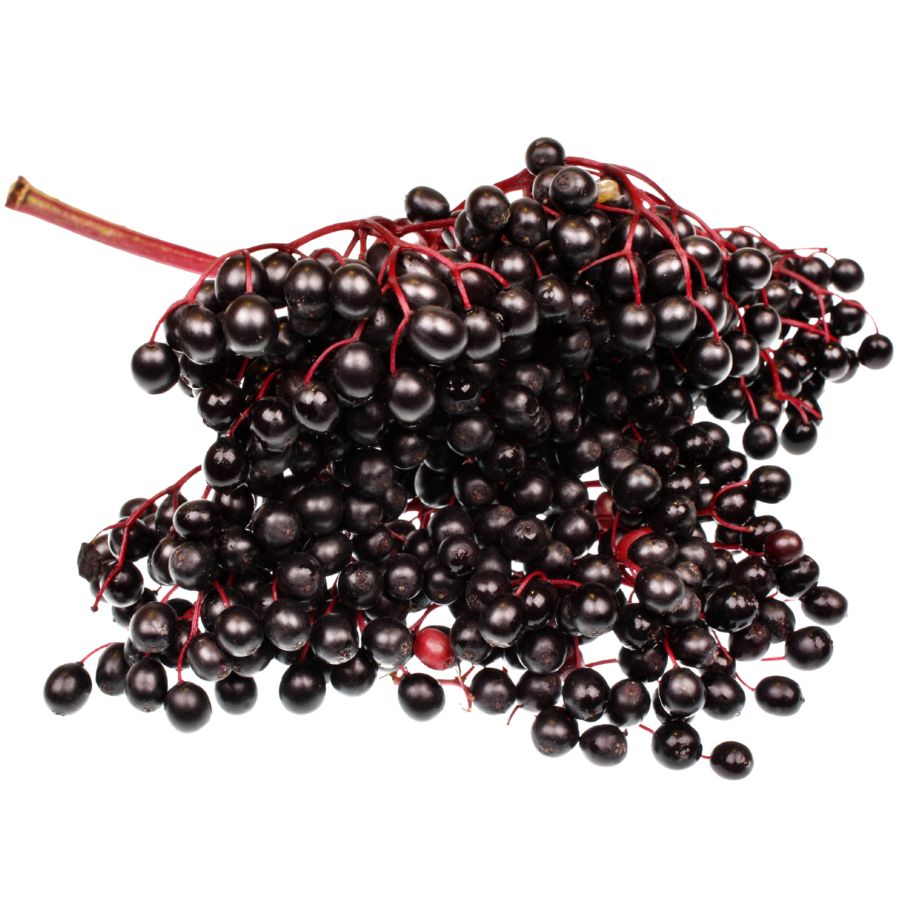
Elderberry is often called American elder, common elder, or sweet elder. It grows as a large, shrubby plant with clusters of tiny white flowers that eventually turn into deep purple to black berries.
You can recognize elderberry by its compound leaves with five to eleven serrated leaflets and its flat-topped flower clusters. One important thing to watch out for is its toxic lookalikes, like pokeweed, which has very different smooth-edged leaves and reddish stems.
The ripe berries have a tart, almost earthy flavor and a soft texture when cooked. People usually cook elderberries into syrups, jams, pies, or wine because eating raw berries can cause nausea.
Only the ripe, cooked berries and flowers are edible, while the leaves, stems, and unripe berries are toxic. Always take care to strip the berries cleanly from their stems before using them, as even small bits of stem can cause problems.
Stinging Nettle (Urtica dioica)
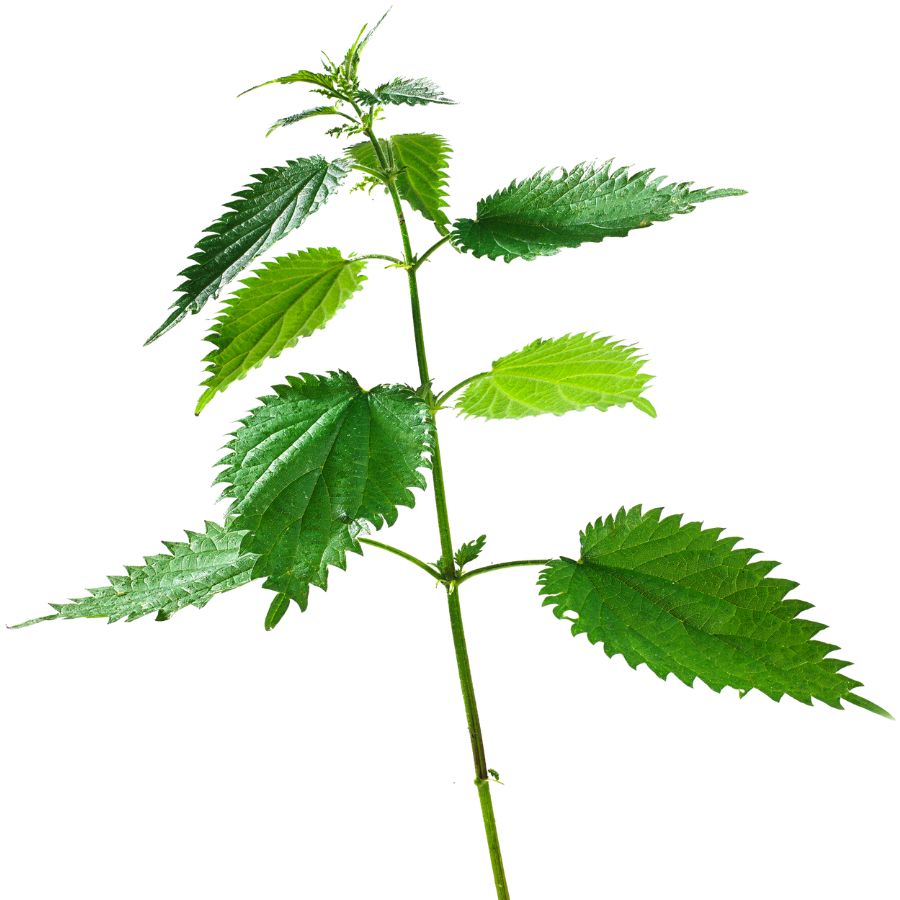
Stinging nettle is also known as burn weed or devil leaf, and it definitely earns those names. The tiny hairs on its leaves and stems can leave a painful, tingling rash if you brush against it raw, so always wear gloves when handling it.
Once it’s cooked or dried, those stingers lose their punch, and the leaves turn mild and slightly earthy in flavor. The texture softens too, making it a solid substitute for spinach in soups, pastas, or even as a simple sauté.
The young leaves and tender tops are what you want to collect. Avoid the tough lower stems and older leaves, which can be gritty or unpleasant to chew.
Some people confuse stinging nettle with purple deadnettle or henbit, but those don’t sting and have more rounded, fuzzy leaves. If the plant doesn’t make your skin react, it’s not stinging nettle.
Toothwort (Cardamine concatenata)
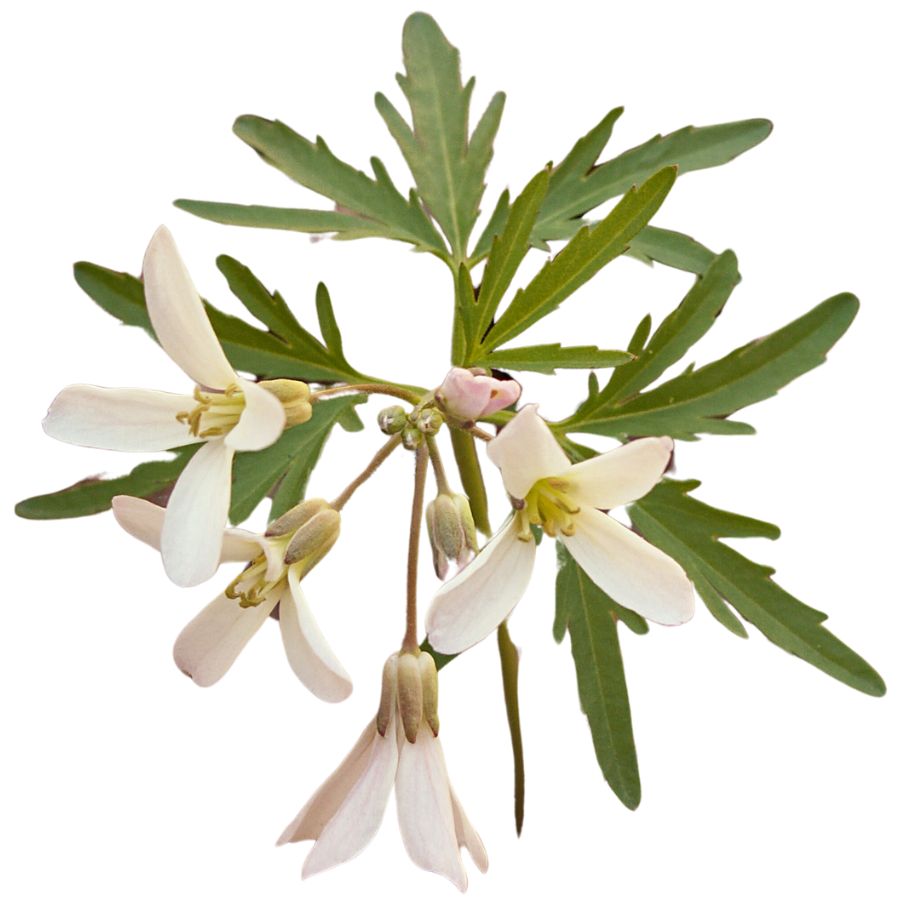
Toothwort, often referred to as pepperroot or crinkleroot, has ragged-edged basal leaves and a string of knobby white rhizomes underground that look like a broken necklace. The rhizomes deliver a pungent flavor somewhere between mustard and horseradish, with a satisfying crunch.
Some people mistake it for cutleaf toothwort, which is also edible, but the more deeply lobed leaves and less spicy root can help you distinguish the two. A bigger concern is confusing it with young hellebore shoots, which lack the segmented roots and are toxic.
The roots can be eaten raw or lightly cooked and are especially good grated into vinegar-based slaws or added to mustards. If you’re fermenting vegetables, adding shaved crinkleroot gives the mix a lively heat.
Leaves and flowers are edible but lack the punch of the rhizome and tend to wilt quickly, making them less useful. You don’t need to cook the root, but heating it slightly can mellow the bite without losing the flavor.
Shepherd’s Purse (Capsella bursa-pastoris)
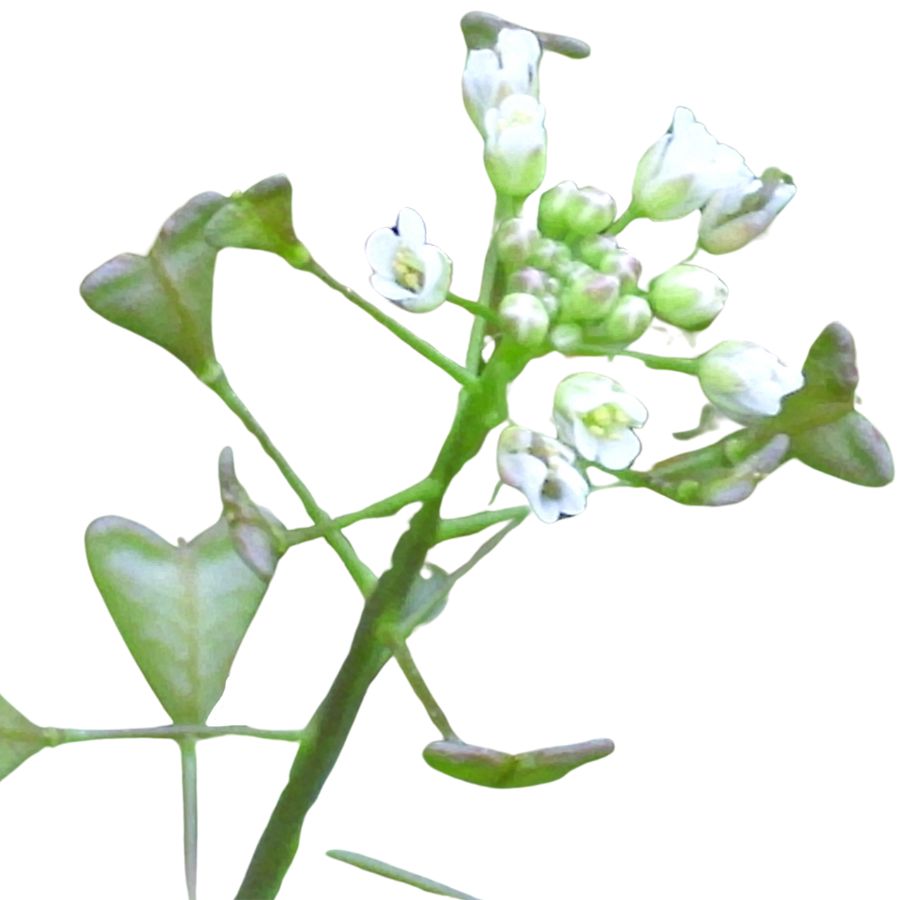
Shepherd’s purse grows low to the ground with small white flowers and flat, heart-shaped seed pods that hang beneath the leaves. You can eat the young leaves raw or cooked, but the seed pods have a spicier kick.
Some people mistake it for field pennycress, but pennycress has rounder seed pods and a more pungent smell. The leaves of shepherd’s purse are deeply lobed and often resemble dandelion leaves in shape.
Its flavor is mild and peppery, like a cross between mustard greens and arugula. You can toss the fresh leaves into salads or sauté them with garlic and oil.
The older leaves turn bitter and tough, so it’s better to use them early. Avoid harvesting near roadsides or disturbed soils, as the plant can pull up contaminants.
Wild Strawberry (Fragaria virginiana)
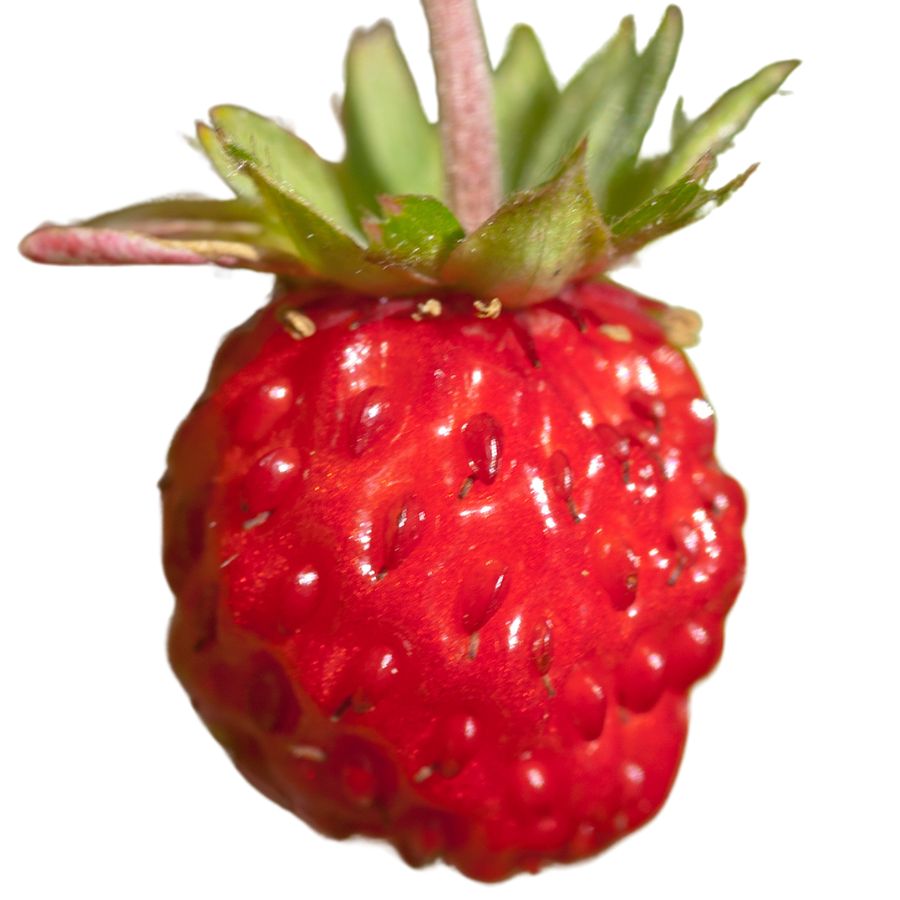
Wild strawberry, sometimes called Virginia strawberry or mountain strawberry, grows low to the ground with three-part leaves that have jagged edges. The small white flowers with yellow centers eventually give way to tiny, bright red fruits nestled close to the soil.
The fruits are sweet with a burst of tartness, and their texture is much softer than the large cultivated strawberries you find in stores. You can eat them raw, mix them into jams, or bake them into pies for a rich, fruity flavor.
Wild strawberry can sometimes be confused with mock strawberry, which has similar leaves but produces dry, flavorless fruits and yellow flowers instead of white. Always check the flower color and taste a small piece before collecting more.
Only the berries and the tender young leaves of wild strawberry are edible, with the leaves often brewed into teas. Be careful not to overharvest because these plants grow slowly and support plenty of small wildlife.
Toxic Plants That Look Like Edible Plants
There are plenty of wild edibles to choose from, but some toxic native plants closely resemble them. Mistaking the wrong one can lead to severe illness or even death, so it’s important to know exactly what you’re picking.
Poison Hemlock (Conium maculatum)
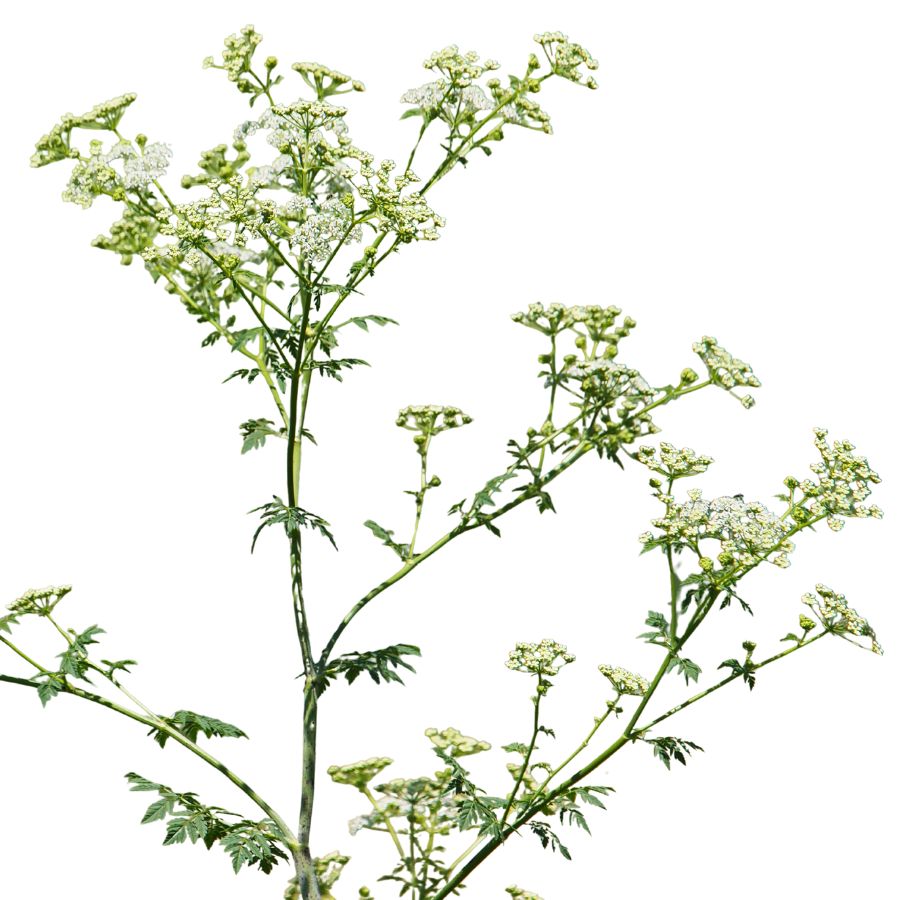
Often mistaken for: Wild carrot (Daucus carota)
Poison hemlock is a tall plant with lacy leaves and umbrella-like clusters of tiny white flowers. It has smooth, hollow stems with purple blotches and grows in sunny places like roadsides, meadows, and stream banks.
Unlike wild carrot, which has hairy stems and a dark central floret, poison hemlock has a musty odor and no flower center spot. It’s extremely toxic; just a small amount can be fatal, and even touching the sap can irritate the skin.
Water Hemlock (Cicuta spp.)
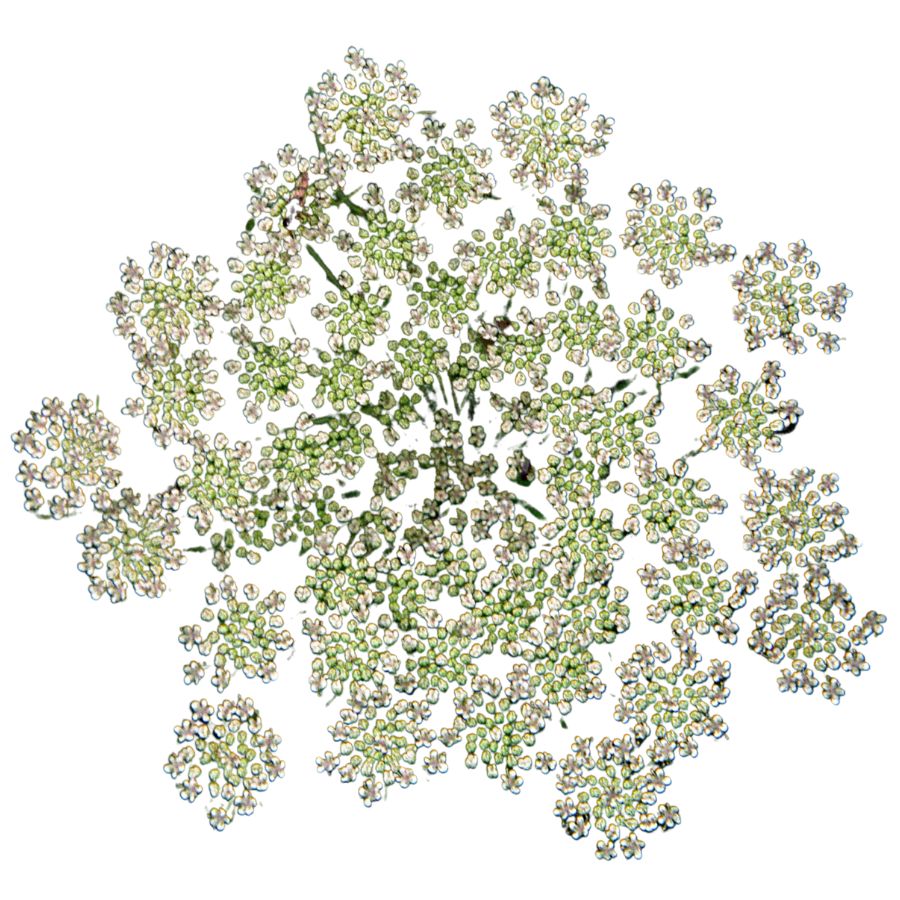
Often mistaken for: Wild parsnip (Pastinaca sativa) or wild celery (Apium spp.)
Water hemlock is a tall, branching plant with umbrella-shaped clusters of small white flowers. It grows in wet places like stream banks, marshes, and ditches, with stems that often show purple streaks or spots.
It can be confused with wild parsnip or wild celery, but its thick, hollow roots have internal chambers and release a yellow, foul-smelling sap when cut. Water hemlock is the most toxic plant in North America, and just a small amount can cause seizures, respiratory failure, and death.
False Hellebore (Veratrum viride)
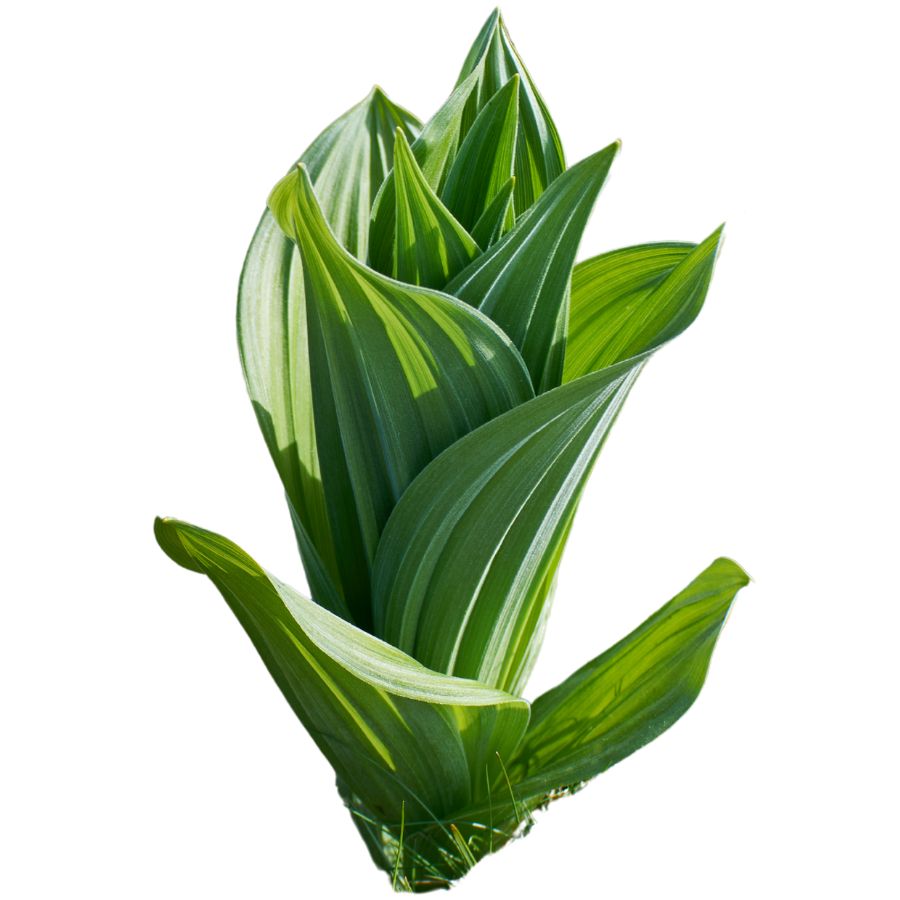
Often mistaken for: Ramps (Allium tricoccum)
False hellebore is a tall plant with broad, pleated green leaves that grow in a spiral from the base, often appearing early in spring. It grows in moist woods, meadows, and along streams.
It’s commonly mistaken for ramps, but ramps have a strong onion or garlic smell, while false hellebore is odorless and later grows a tall flower stalk. The plant is highly toxic, and eating any part can cause nausea, a slowed heart rate, and even death due to its alkaloids that affect the nervous and cardiovascular systems.
Death Camas (Zigadenus spp.)
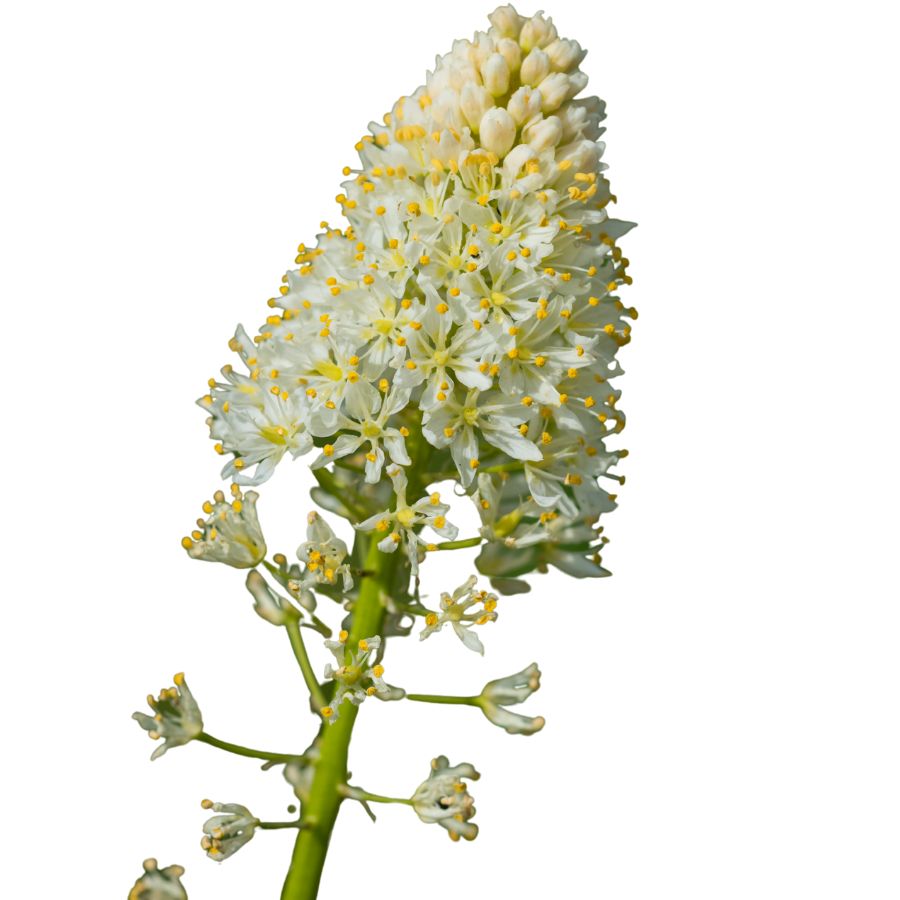
Often mistaken for: Wild onion or wild garlic (Allium spp.)
Death camas is a slender, grass-like plant that grows from underground bulbs and is found in open woods, meadows, and grassy hillsides. It has small, cream-colored flowers in loose clusters atop a tall stalk.
It’s often confused with wild onion or wild garlic due to their similar narrow leaves and habitats, but only Allium plants have a strong onion or garlic scent, while death camas has none. The plant is extremely poisonous, especially the bulbs, and even a small amount can cause nausea, vomiting, a slowed heartbeat, and potentially fatal respiratory failure.
Buckthorn Berries (Rhamnus spp.)
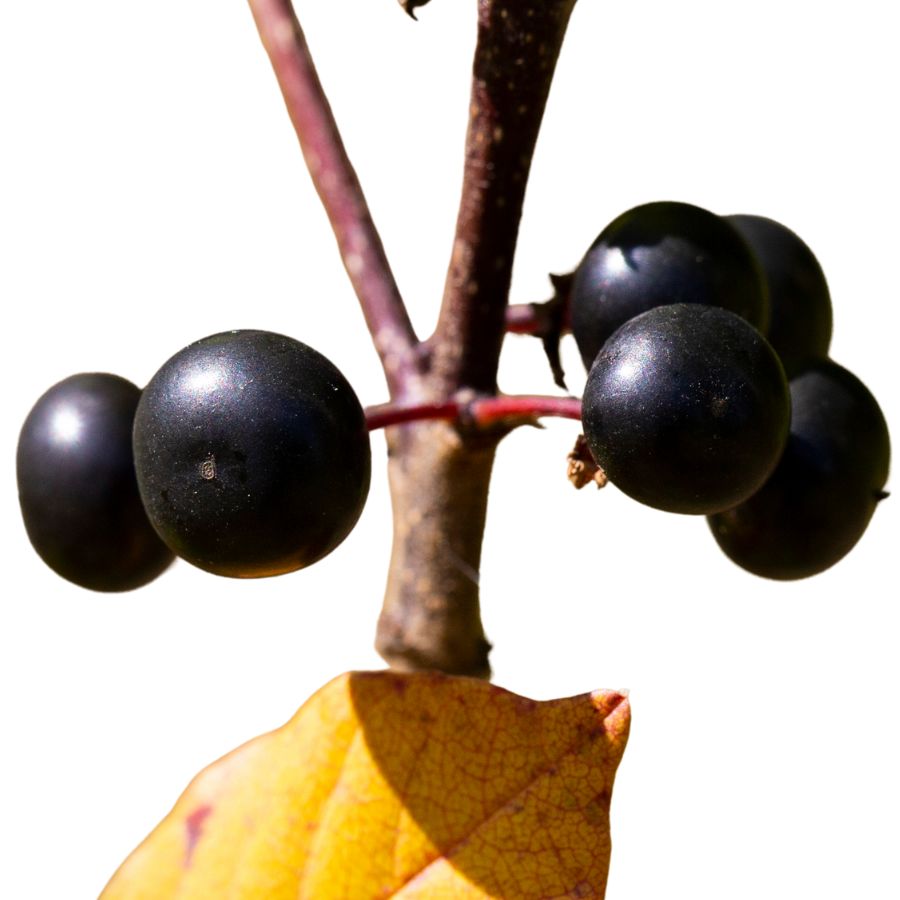
Often mistaken for: Elderberries (Sambucus spp.)
Buckthorn is a shrub or small tree often found along woodland edges, roadsides, and disturbed areas. It produces small, round berries that ripen to dark purple or black and usually grow in loose clusters.
These berries are sometimes mistaken for elderberries and other wild fruits, which also grow in dark clusters, but elderberries form flat-topped clusters on reddish stems while buckthorn berries are more scattered. Buckthorn berries are unsafe to eat as they contain compounds that can cause cramping, vomiting, and diarrhea, and large amounts may lead to dehydration and serious digestive problems.
Mayapple (Podophyllum peltatum)
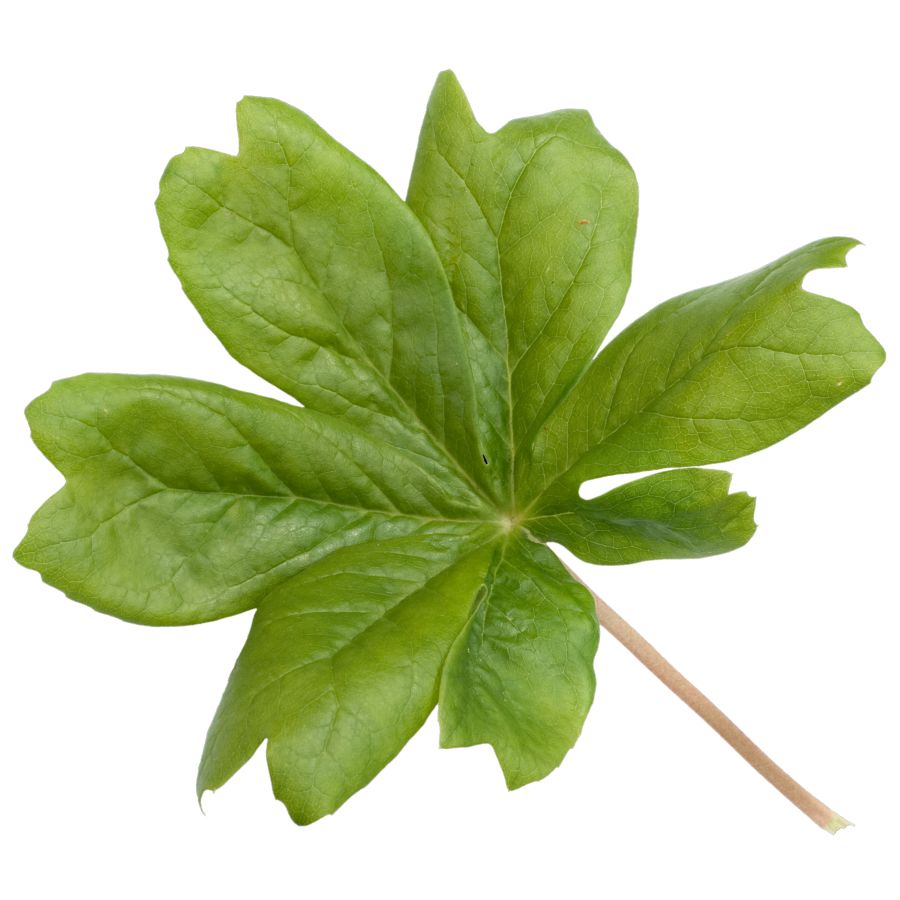
Often mistaken for: Wild grapes (Vitis spp.)
Mayapple is a low-growing plant found in shady forests and woodland clearings. It has large, umbrella-like leaves and produces a single pale fruit hidden beneath the foliage.
The unripe fruit resembles a small green grape, causing confusion with wild grapes, which grow in woody clusters on vines. All parts of the mayapple are toxic except the fully ripe, yellow fruit, which is only safe in small amounts. Eating unripe fruit or other parts can lead to nausea, vomiting, and severe dehydration.
Virginia Creeper (Parthenocissus quinquefolia)
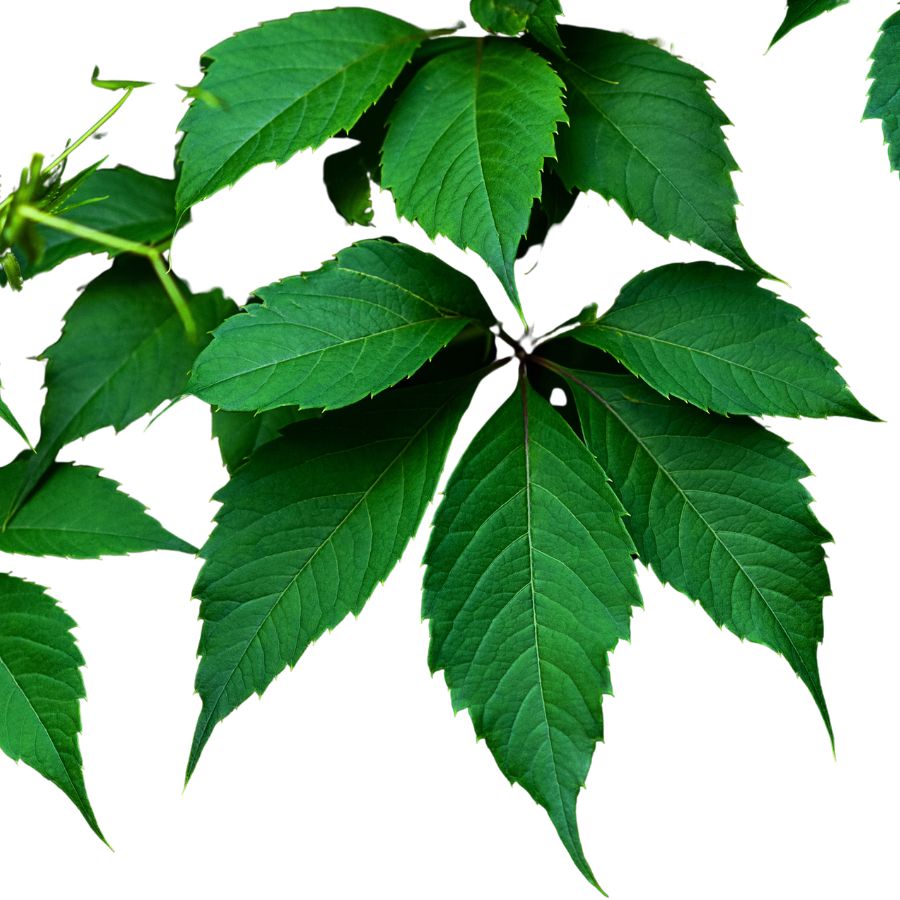
Often mistaken for: Wild grapes (Vitis spp.)
Virginia creeper is a fast-growing vine found on fences, trees, and forest edges. It has five leaflets per stem and produces small, bluish-purple berries from late summer to fall.
It’s often confused with wild grapes since both are climbing vines with similar berries, but grapevines have large, lobed single leaves and tighter fruit clusters. Virginia creeper’s berries are toxic to humans and contain oxalate crystals that can cause nausea, vomiting, and throat irritation.
Castor Bean (Ricinus communis)
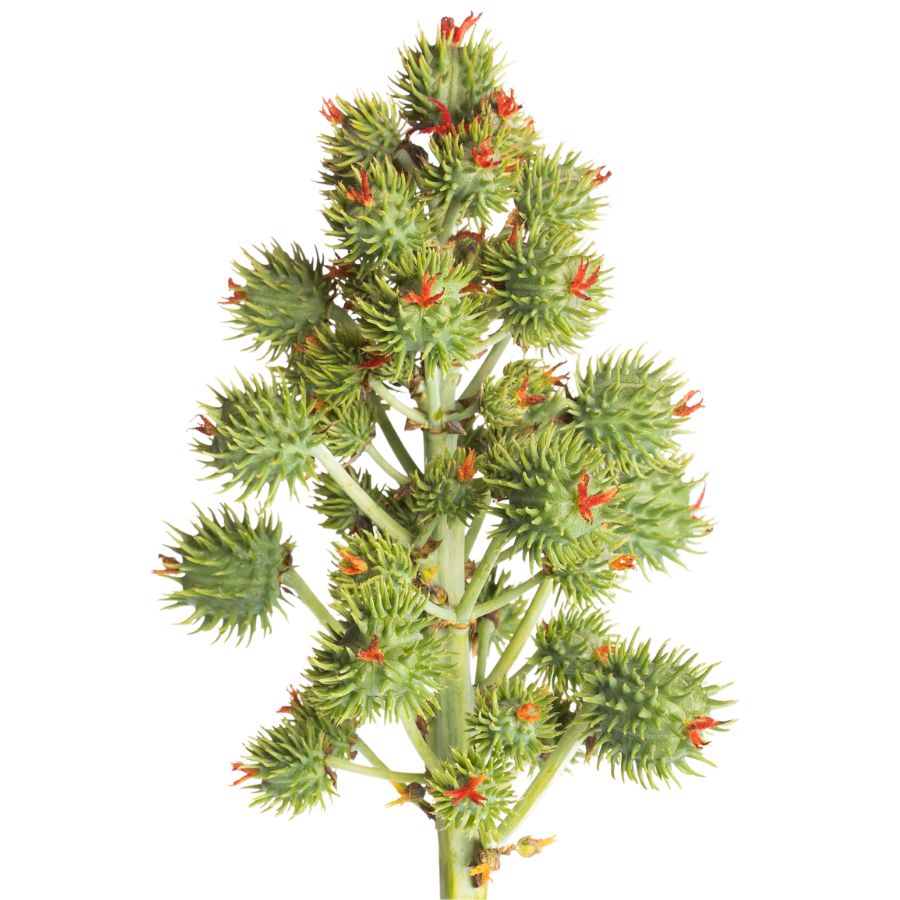
Often mistaken for: Wild rhubarb (Rumex spp. or Rheum spp.)
Castor bean is a bold plant with large, lobed leaves and tall red or green stalks, often found in gardens, along roadsides, and in disturbed areas in warmer regions in the US. Its red-tinged stems and overall size can resemble wild rhubarb to the untrained eye.
Unlike rhubarb, castor bean plants produce spiny seed pods containing glossy, mottled seeds that are extremely toxic. These seeds contain ricin, a deadly compound even in small amounts. While all parts of the plant are toxic, the seeds are especially dangerous and should never be handled or ingested.
A Quick Reminder
Before we get into the specifics about where and how to find these mushrooms, we want to be clear that before ingesting any wild mushroom, it should be identified with 100% certainty as edible by someone qualified and experienced in mushroom identification, such as a professional mycologist or an expert forager. Misidentification of mushrooms can lead to serious illness or death.
All mushrooms have the potential to cause severe adverse reactions in certain individuals, even death. If you are consuming mushrooms, it is crucial to cook them thoroughly and properly and only eat a small portion to test for personal tolerance. Some people may have allergies or sensitivities to specific mushrooms, even if they are considered safe for others.
The information provided in this article is for general informational and educational purposes only. Foraging for wild mushrooms involves inherent risks.
How to Get the Best Results Foraging
Safety should always come first when it comes to foraging. Whether you’re in a rural forest or a suburban greenbelt, knowing how to harvest wild foods properly is a key part of staying safe and respectful in the field.
Always Confirm Plant ID Before You Harvest Anything
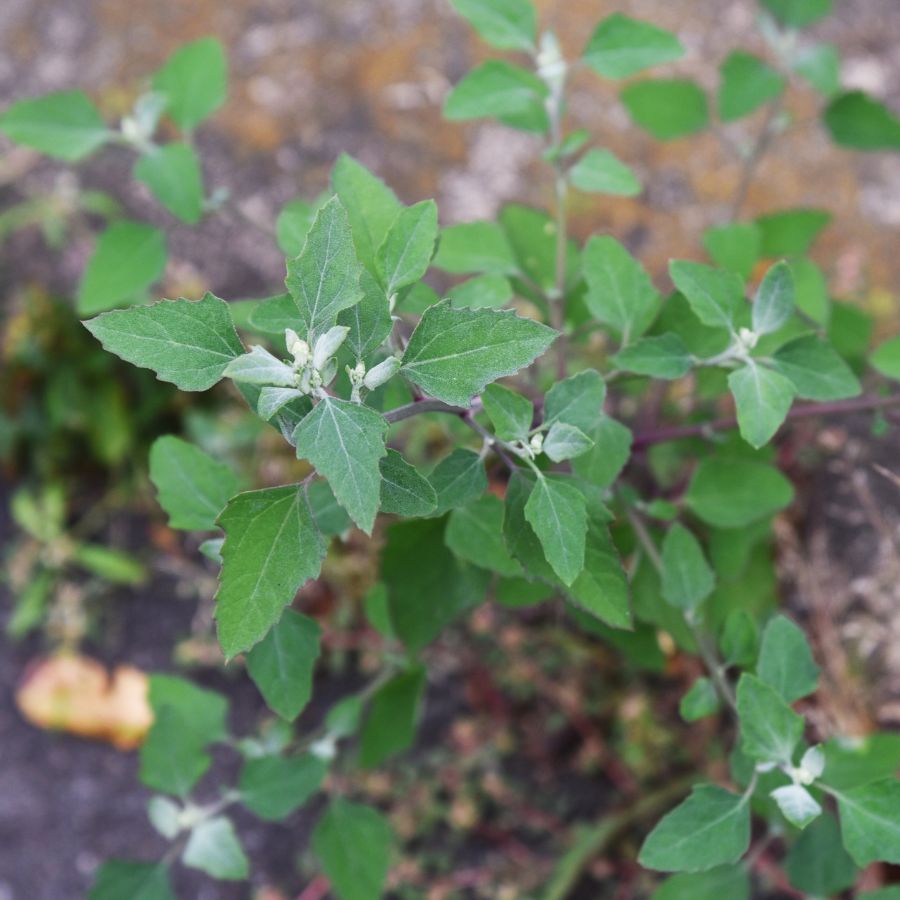
Knowing exactly what you’re picking is the most important part of safe foraging. Some edible plants have nearly identical toxic lookalikes, and a wrong guess can make you seriously sick.
Use more than one reliable source to confirm your ID, like field guides, apps, and trusted websites. Pay close attention to small details. Things like leaf shape, stem texture, and how the flowers or fruits are arranged all matter.
Not All Edible Plants Are Safe to Eat Whole
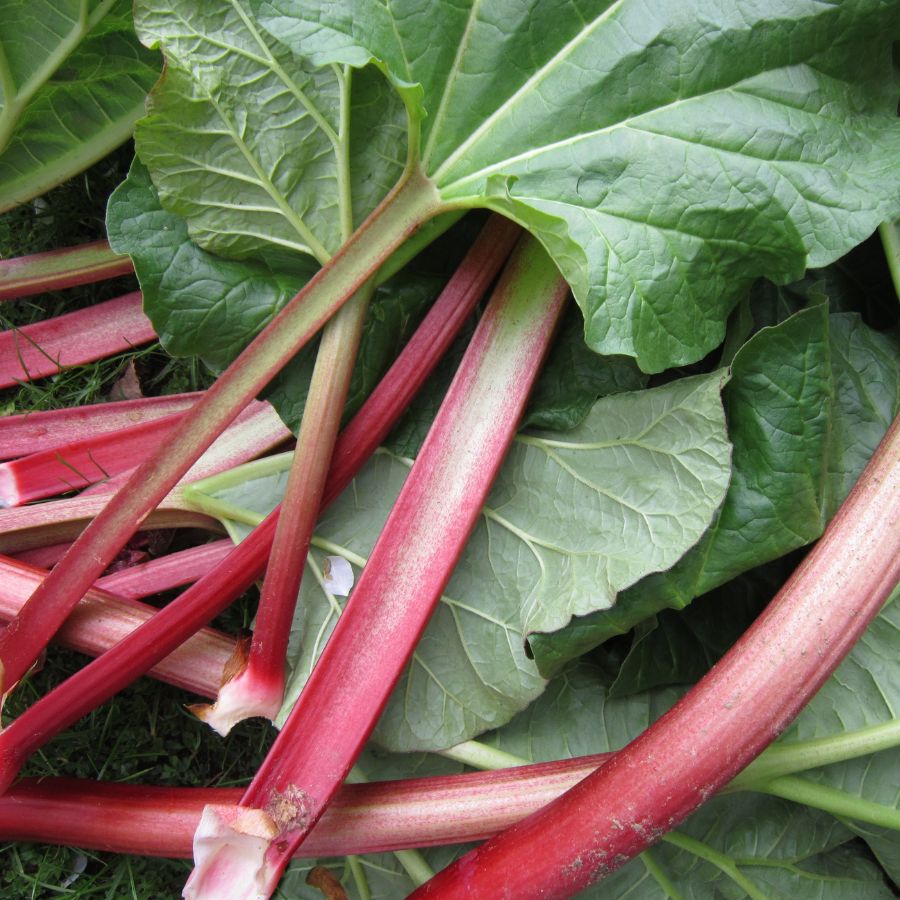
Just because a plant is edible doesn’t mean every part of it is safe. Some plants have leaves, stems, or seeds that can be toxic if eaten raw or prepared the wrong way.
For example, pokeweed is only safe when young and properly cooked, while elderberries need to be heated before eating. Rhubarb stems are fine, but the leaves are poisonous. Always look up which parts are edible and how they should be handled.
Avoid Foraging in Polluted or Contaminated Areas
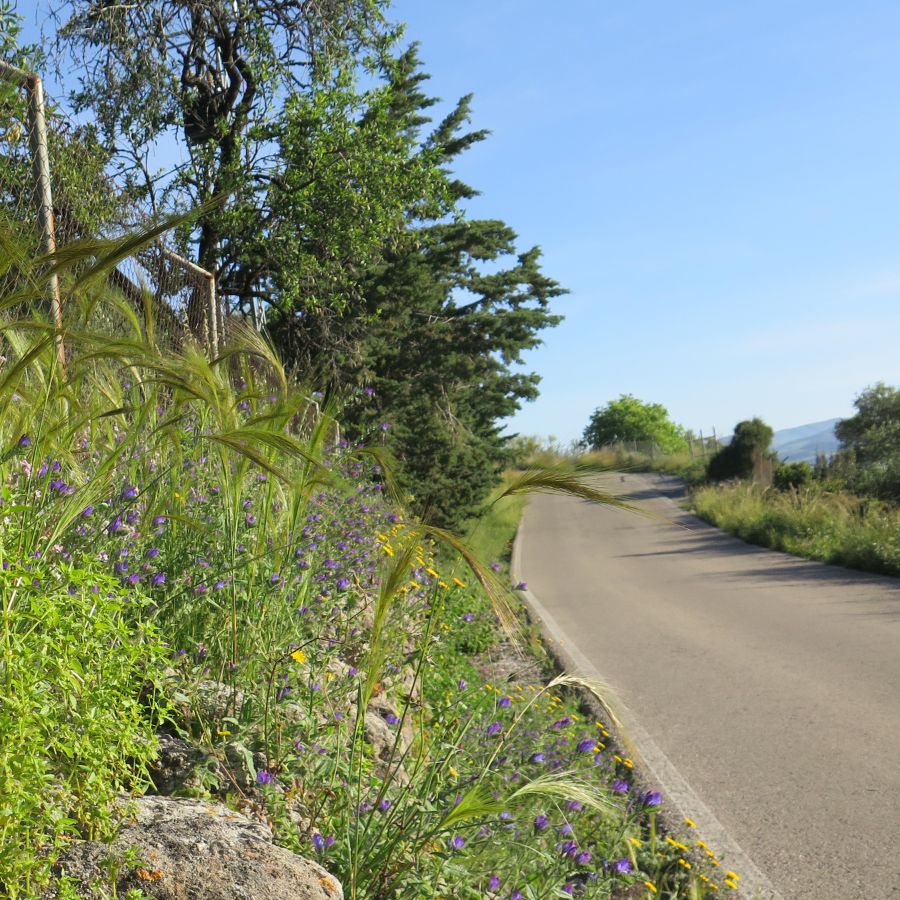
Where you forage matters just as much as what you pick. Plants growing near roads, buildings, or farmland might be coated in chemicals or growing in polluted soil.
Even safe plants can take in harmful substances from the air, water, or ground. Stick to clean, natural areas like forests, local parks that allow foraging, or your own yard when possible.
Don’t Harvest More Than What You Need
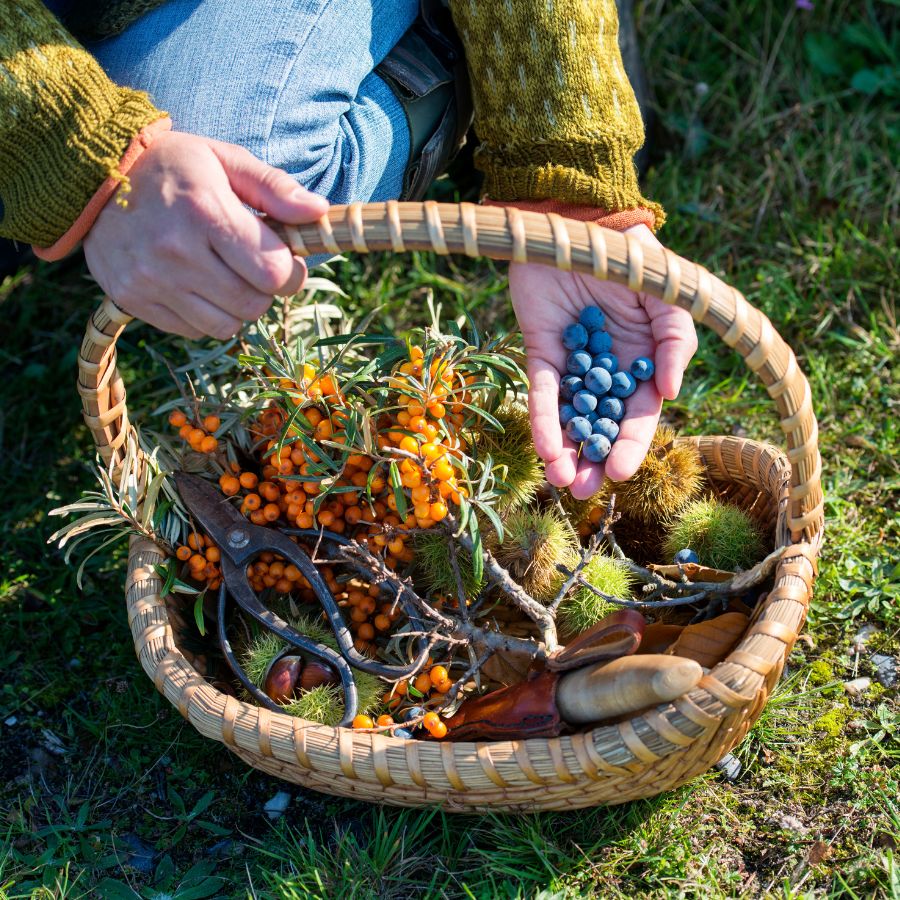
When you forage, take only what you plan to use. Overharvesting can hurt local plant populations and reduce future growth in that area.
Leaving plenty behind helps plants reproduce and supports wildlife that depends on them. It also ensures other foragers have a chance to enjoy the same resources.
Protect Yourself and Your Finds with Proper Foraging Gear

Having the right tools makes foraging easier and safer. Gloves protect your hands from irritants like stinging nettle, and a good knife or scissors lets you harvest cleanly without damaging the plant.
Use a basket or breathable bag to carry what you collect. Plastic bags hold too much moisture and can cause your greens to spoil before you get home.
This forager’s toolkit covers the essentials for any level of experience.
Watch for Allergic Reactions When Trying New Wild Foods

Even if a wild plant is safe to eat, your body might react to it in unexpected ways. It’s best to try a small amount first and wait to see how you feel.
Be extra careful with kids or anyone who has allergies. A plant that’s harmless for one person could cause a reaction in someone else.
Check Local Rules Before Foraging on Any Land
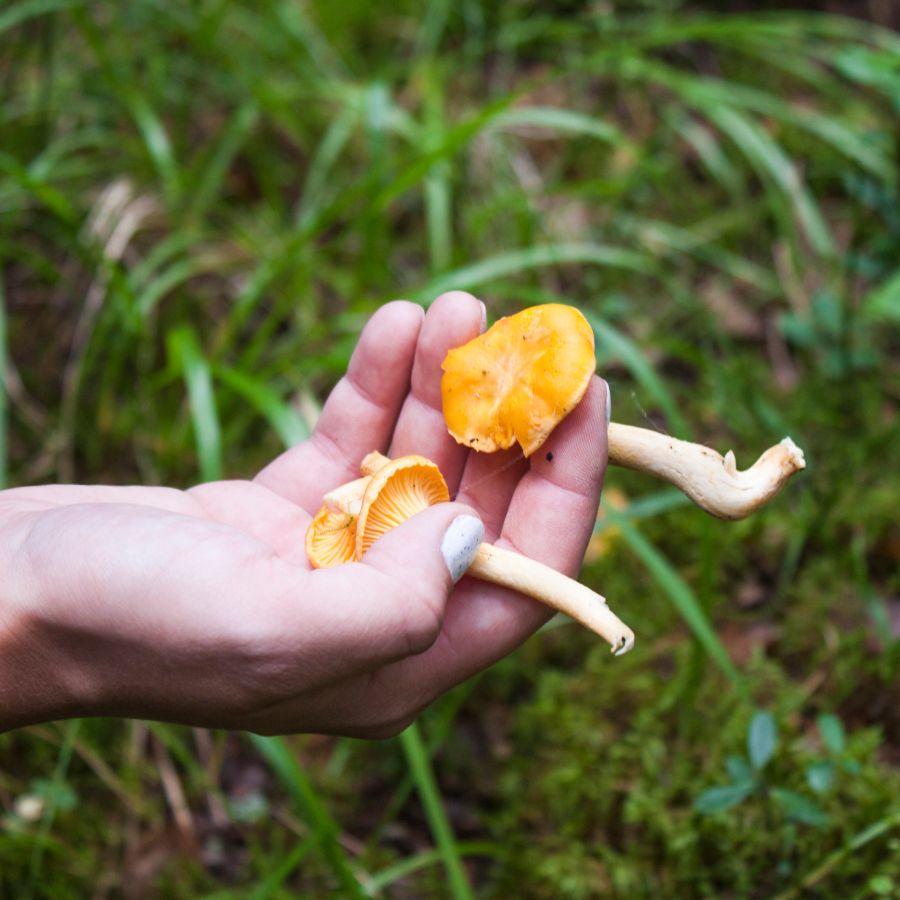
Before you start foraging, make sure you know the rules for the area you’re in. What’s allowed in one spot might be completely off-limits just a few miles away.
Some public lands permit limited foraging, while others, like national parks, usually don’t allow it at all. If you’re on private property, always get permission first.
Before you head out
Before embarking on any foraging activities, it is essential to understand and follow local laws and guidelines. Always confirm that you have permission to access any land and obtain permission from landowners if you are foraging on private property. Trespassing or foraging without permission is illegal and disrespectful.
For public lands, familiarize yourself with the foraging regulations, as some areas may restrict or prohibit the collection of mushrooms or other wild foods. These regulations and laws are frequently changing so always verify them before heading out to hunt. What we have listed below may be out of date and inaccurate as a result.
Where to Find Forageables in the State
There is a range of foraging spots where edible plants grow naturally and often in abundance:
| Plant | Locations |
| Blackberry (Rubus allegheniensis) | – Mark Twain National Forest – Katy Trail State Park – Cuivre River State Park |
| Dandelion (Taraxacum officinale) | – Rock Bridge Memorial State Park – Forest Park, St. Louis – Prairie State Park |
| Elderberry (Sambucus canadensis) | – Big Oak Tree State Park – Meramec State Park – Lake of the Ozarks State Park |
| Wild Grape (Vitis riparia) | – Castlewood State Park – Ha Ha Tonka State Park – Trail of Tears State Park |
| American Persimmon (Diospyros virginiana) | – Johnson’s Shut-Ins State Park – Elephant Rocks State Park – Taum Sauk Mountain State Park |
| Lamb’s Quarters (Chenopodium album) | – Weldon Spring Conservation Area – Busch Wildlife Conservation Area – Columbia Bottom Conservation Area |
| Meadow Garlic (Allium canadense) | – Shaw Nature Reserve – Babler State Park – Hawn State Park |
| Wild Garlic (Allium vineale) | – Roaring River State Park – Bennett Spring State Park – Montauk State Park |
| Milkweed (Asclepias syriaca) | – Prairie State Park – Loess Bluffs National Wildlife Refuge – Mingo National Wildlife Refuge |
| Pawpaw (Asimina triloba) | – Cuivre River State Park – Rock Bridge Memorial State Park – Big Oak Tree State Park |
| Mulberry (Morus rubra) | – Forest Park, St. Louis – Springfield Conservation Nature Center – Mark Twain National Forest |
| Plantain (Plantago major) | – Katy Trail State Park – Castlewood State Park – Rockwoods Reservation |
| Wood Sorrel (Oxalis stricta) | – Shaw Nature Reserve – Babler State Park – Weldon Spring Conservation Area |
| Jerusalem Artichoke (Helianthus tuberosus) | – Prairie State Park – Loess Bluffs National Wildlife Refuge – Mingo National Wildlife Refuge |
| Curly Dock (Rumex crispus) | – Columbia Bottom Conservation Area – Busch Wildlife Conservation Area – Rock Bridge Memorial State Park |
| Chickweed (Stellaria media) | – Forest Park, St. Louis – Springfield Conservation Nature Center – Rockwoods Reservation |
| American Plum (Prunus americana) | – Cuivre River State Park – Ha Ha Tonka State Park – Johnson’s Shut-Ins State Park |
| Wild Strawberry (Fragaria virginiana) | – Shaw Nature Reserve – Babler State Park – Hawn State Park |
| Stinging Nettle (Urtica dioica) | – Roaring River State Park – Bennett Spring State Park – Montauk State Park |
| Cattail (Typha latifolia) | – Mingo National Wildlife Refuge – Loess Bluffs National Wildlife Refuge – Columbia Bottom Conservation Area |
| Spicebush (Lindera benzoin) | – Rock Bridge Memorial State Park – Big Oak Tree State Park – Taum Sauk Mountain State Park |
| Violet (Viola sororia) | – Forest Park, St. Louis – Springfield Conservation Nature Center – Rockwoods Reservation |
| Shepherd’s Purse (Capsella bursa-pastoris) | – Shaw Nature Reserve – Babler State Park – Weldon Spring Conservation Area |
| Henbit (Lamium amplexicaule) | – Katy Trail State Park – Castlewood State Park – Rockwoods Reservation |
| Greenbrier (Smilax spp.) | – Cuivre River State Park – Ha Ha Tonka State Park – Johnson’s Shut-Ins State Park |
| Redbud (Cercis canadensis) | – Shaw Nature Reserve – Babler State Park – Hawn State Park |
| Yarrow (Achillea millefolium) | – Prairie State Park – Loess Bluffs National Wildlife Refuge – Mingo National Wildlife Refuge |
| Wild Bergamot (Monarda fistulosa) | – Columbia Bottom Conservation Area – Busch Wildlife Conservation Area – Rock Bridge Memorial State Park |
| Sassafras (Sassafras albidum) | – Forest Park, St. Louis – Springfield Conservation Nature Center – Mark Twain National Forest |
| Carolina Rose (Rosa carolina) | – Shaw Nature Reserve – Babler State Park – Weldon Spring Conservation Area |
| Sunflower (Helianthus annuus) | – Prairie State Park – Loess Bluffs National Wildlife Refuge – Mingo National Wildlife Refuge |
| Peppergrass (Lepidium virginicum) | – Columbia Bottom Conservation Area – Busch Wildlife Conservation Area – Rock Bridge Memorial State Park |
| Goldenrod (Solidago spp.) | – Forest Park, St. Louis – Springfield Conservation Nature Center – Rockwoods Reservation |
| Hairy Bittercress (Cardamine hirsuta) | – Shaw Nature Reserve – Babler State Park – Hawn State Park |
| Wild Mint (Mentha arvensis) | – Roaring River State Park – Bennett Spring State Park – Montauk State Park |
| Smartweed (Persicaria hydropiper) | – Mingo National Wildlife Refuge – Loess Bluffs National Wildlife Refuge – Columbia Bottom Conservation Area |
| Hickory (Carya spp.) | – Cuivre River State Park – Ha Ha Tonka State Park – Johnson’s Shut-Ins State Park |
| Acorn (Quercus spp.) | – Shaw Nature Reserve – Babler State Park – Weldon Spring Conservation Area |
| Hazelnut (Corylus americana) | – Prairie State Park – Loess Bluffs National Wildlife Refuge – Mingo National Wildlife Refuge |
| Black Walnut (Juglans nigra) | – Columbia Bottom Conservation Area – Busch Wildlife Conservation Area – Rock Bridge Memorial State Park |
| Amaranth (Amaranthus retroflexus) | – Forest Park, St. Louis – Springfield Conservation Nature Center – Rockwoods Reservation |
| Common Evening Primrose (Oenothera biennis) | – Shaw Nature Reserve – Babler State Park – Hawn State Park |
| Wild Mustard (Sinapis arvensis) | – Roaring River State Park – Bennett Spring State Park – Montauk State Park |
| Toothwort (Cardamine concatenata) | – Mingo National Wildlife Refuge – Loess Bluffs National Wildlife Refuge – Columbia Bottom Conservation Area |
| Groundnut (Apios americana) | – Cuivre River State Park – Ha Ha Tonka State Park – Johnson’s Shut-Ins State Park |
| Sorrel (Rumex acetosella) | – Shaw Nature Reserve – Babler State Park – Weldon Spring Conservation Area |
| Narrowleaf Plantain (Plantago lanceolata) | – Prairie State Park – Loess Bluffs National Wildlife Refuge – Mingo National Wildlife Refuge |
| Red Clover (Trifolium pratense) | – Columbia Bottom Conservation Area – Busch Wildlife Conservation Area – Rock Bridge Memorial State Park |
| White Clover (Trifolium repens) | – Forest Park, St. Louis – Springfield Conservation Nature Center – Rockwoods Reservation |
| Watercress (Nasturtium officinale) | – Shaw Nature Reserve – Babler State Park – Hawn State Park |
| Thistle (Cirsium spp.) | – Roaring River State Park – Bennett Spring State Park – Montauk State Park |
| Wild Carrot (Daucus carota) | – Mingo National Wildlife Refuge – Loess Bluffs National Wildlife Refuge – Columbia Bottom Conservation Area |
| Bullrush (Schoenoplectus spp.) | – Cuivre River State Park – Ha Ha Tonka State Park – Johnson’s Shut-Ins State Park |
| Wild Parsnip (Pastinaca sativa) | – Shaw Nature Reserve – Babler State Park – Weldon Spring Conservation Area |
| Pennycress (Thlaspi arvense) | – Prairie State Park – Loess Bluffs National Wildlife Refuge – Mingo National Wildlife Refuge |
| Chufa (Cyperus esculentus) | – Columbia Bottom Conservation Area – Busch Wildlife Conservation Area – Rock Bridge Memorial State Park |
| Hop Tree (Ptelea trifoliata) | – Forest Park, St. Louis – Springfield Conservation Nature Center – Rockwoods Reservation |
| Mayapple (Podophyllum peltatum) | – Shaw Nature Reserve – Babler State Park – Hawn State Park |
Peak Foraging Seasons
Different edible plants grow at different times of year, depending on the season and weather. Timing your search makes all the difference.
Spring
Spring brings a fresh wave of wild edible plants as the ground thaws and new growth begins:
| Plant | Months | Best Weather Conditions |
| Dandelion (Taraxacum officinale) | March – May | Cool, sunny days after rain |
| Meadow Garlic (Allium canadense) | March – May | Moist soil, mild temperatures |
| Wild Garlic (Allium vineale) | March – May | Damp ground, overcast or post-rain |
| Chickweed (Stellaria media) | February – May | Cool, moist conditions |
| Wood Sorrel (Oxalis stricta) | April – June | Partly cloudy, humid mornings |
| Henbit (Lamium amplexicaule) | February – April | Moist soil, mild temps |
| Curly Dock (Rumex crispus) | March – May | Rainy to partly sunny weather |
| Hairy Bittercress (Cardamine hirsuta) | February – April | Wet soil, overcast days |
| Violet (Viola sororia) | March – May | Humid air and scattered light |
| Redbud (Cercis canadensis) | March – May | Warm afternoons, light rain |
| Mayapple (Podophyllum peltatum) | April – May | Shaded woods after light rain |
| Toothwort (Cardamine concatenata) | March – May | Moist forest soil, light overcast |
| Pennycress (Thlaspi arvense) | March – May | Open fields after a spring shower |
| Shepherd’s Purse (Capsella bursa-pastoris) | March – May | Cool and slightly damp weather |
| Watercress (Nasturtium officinale) | March – May | Clear flowing streams, cool temps |
| Spicebush (Lindera benzoin) | March – May | Moist woodland air, filtered sunlight |
| Sassafras (Sassafras albidum) | March – May | Warm, humid conditions in open woods |
Summer
Summer is a peak season for foraging, with fruits, flowers, and greens growing in full force:
| Plant | Months | Best Weather Conditions |
| Blackberry (Rubus allegheniensis) | June – August | Sunny days after light rainfall |
| Elderberry (Sambucus canadensis) | July – August | Hot, sunny days with rich soil moisture |
| Wild Grape (Vitis riparia) | June – August | Humid, warm evenings |
| American Persimmon (Diospyros virginiana) | July – September | Dry heat followed by scattered rain |
| Lamb’s Quarters (Chenopodium album) | June – August | Sunny days with occasional storms |
| Milkweed (Asclepias syriaca) | June – August | Warm, dry fields |
| Pawpaw (Asimina triloba) | August | Hot, humid river bottoms |
| Mulberry (Morus rubra) | June – July | Sunny skies, moderate humidity |
| Plantain (Plantago major) | May – August | Dry afternoons following overnight dew |
| Wild Strawberry (Fragaria virginiana) | May – June | Early morning after light rains |
| Cattail (Typha latifolia) | June – August | Warm wetlands with steady water levels |
| Yarrow (Achillea millefolium) | May – July | Sunny meadows and disturbed ground |
| Wild Bergamot (Monarda fistulosa) | June – August | Dry prairies under full sun |
| Carolina Rose (Rosa carolina) | May – July | Light breezes and sunny skies |
| Sunflower (Helianthus annuus) | July – September | Full sun and well-drained fields |
| Peppergrass (Lepidium virginicum) | June – August | Dry, warm roadside ditches |
| Wild Mint (Mentha arvensis) | June – August | Humid areas with partial shade |
| Smartweed (Persicaria hydropiper) | July – September | Damp soil with warm air temps |
| Amaranth (Amaranthus retroflexus) | July – September | Hot, dry areas near disturbed soils |
| Common Evening Primrose (Oenothera biennis) | June – August | Sandy or gravelly ground after storms |
| Wild Mustard (Sinapis arvensis) | May – July | Open, sunny clearings post-rain |
| Groundnut (Apios americana) | July – September | Moist forest edges and streambanks |
| Sorrel (Rumex acetosella) | May – July | Light rain and partial shade |
| Narrowleaf Plantain (Plantago lanceolata) | May – August | Dry, sunny grasslands |
| Red Clover (Trifolium pratense) | May – August | Open meadows with consistent sunlight |
| White Clover (Trifolium repens) | May – August | Damp grassy areas with moderate heat |
| Thistle (Cirsium spp.) | June – September | Dry fields under full sun |
| Wild Carrot (Daucus carota) | June – August | Fields during hot afternoons |
| Bullrush (Schoenoplectus spp.) | June – August | Standing water with light breeze |
| Wild Parsnip (Pastinaca sativa) | June – August | Sunny ditches and disturbed soils |
| Chufa (Cyperus esculentus) | June – August | Sandy wet ground near streams |
| Hop Tree (Ptelea trifoliata) | June – August | Lightly wooded edges on warm days |
Fall
As temperatures drop, many edible plants shift underground or produce their last harvests:
| Plant | Months | Best Weather Conditions |
| American Persimmon (Diospyros virginiana) | September – October | Cool nights and sunny afternoons |
| Pawpaw (Asimina triloba) | September | Humid, shaded riverbanks |
| Hickory (Carya spp.) | September – October | Cool, crisp mornings and dry air |
| Acorn (Quercus spp.) | September – November | Dry forest floor after windstorms |
| Hazelnut (Corylus americana) | September | Slightly breezy and dry |
| Black Walnut (Juglans nigra) | September – October | Dry days with minimal rain |
| Jerusalem Artichoke (Helianthus tuberosus) | September – November | After first frost in sunny soil |
| Goldenrod (Solidago spp.) | August – October | Open meadows during late warmth |
| Wild Grape (Vitis riparia) | August – September | Warm dusk with morning dew |
| Wild Mint (Mentha arvensis) | September – October | Moist soil, partial shade |
| Smartweed (Persicaria hydropiper) | September – October | Lowland edges during mild days |
| Wild Carrot (Daucus carota) | September – October | Cool air and disturbed soil |
| Groundnut (Apios americana) | September – October | Forest edges with moist soil |
| Chufa (Cyperus esculentus) | September – October | Warm, sandy streambanks |
| Bullrush (Schoenoplectus spp.) | September – October | Wetlands in mild weather |
Winter
Winter foraging is limited but still possible, with hardy plants and preserved growth holding on through the cold:
| Plant | Months | Best Weather Conditions |
| Dandelion (Taraxacum officinale) | December – February (mild winters) | Warmer-than-usual days with moist soil |
| Chickweed (Stellaria media) | December – February | Cool, damp days with limited sun |
| Henbit (Lamium amplexicaule) | December – February | Overcast skies with soft ground |
| Shepherd’s Purse (Capsella bursa-pastoris) | December – February | Unfrozen soil on mild afternoons |
| Hairy Bittercress (Cardamine hirsuta) | December – February | Moist low light environments |
| Curly Dock (Rumex crispus) | December – February | Partly sunny with consistent dew |
| Watercress (Nasturtium officinale) | December – February | Cold-flowing streams, above freezing |
| Sorrel (Rumex acetosella) | December – February | Light frost with full morning sun |
| Red Clover (Trifolium pratense) | December – February | Dormant but harvestable during thaws |
| White Clover (Trifolium repens) | December – February | Brief warm spells, grassy ground |
| Plantain (Plantago major) | December – February | Edible in early thaw or soft freeze |
One Final Disclaimer
The information provided in this article is for general informational and educational purposes only. Foraging for wild plants and mushrooms involves inherent risks. Some wild plants and mushrooms are toxic and can be easily mistaken for edible varieties.
Before ingesting anything, it should be identified with 100% certainty as edible by someone qualified and experienced in mushroom and plant identification, such as a professional mycologist or an expert forager. Misidentification can lead to serious illness or death.
All mushrooms and plants have the potential to cause severe adverse reactions in certain individuals, even death. If you are consuming foraged items, it is crucial to cook them thoroughly and properly and only eat a small portion to test for personal tolerance. Some people may have allergies or sensitivities to specific mushrooms and plants, even if they are considered safe for others.
Foraged items should always be fully cooked with proper instructions to ensure they are safe to eat. Many wild mushrooms and plants contain toxins and compounds that can be harmful if ingested.

